SAVAGE MARK II BTVLSS .22 CAL. RIFLE REVIEWThis rimfire rifle is one of the WORST NEW GUNS that I have ever owned as
far as accuracy right out of the box! For those that have purchased
this rifle and it shoots like a dream, you probably have one that should be
sold as "One of a Thousand" like
the ole
Winchester 73 movie starring Jimmy Stewart!
As I have posted many, many times on this website,
"Most of the time, you get what you pay for."
MODIFICATION WARNING DISCLAIMER
The below information in its entirety is for
ENTERTAINMENT PURPOSES ONLY
from a personal liability standpoint and
do not try this at home. Modifications to firearms and
ammunition can cause
serious bodily injury and ultimate death. The below modifications to the
Accu-Trigger will certainly void your Savage product warranty and relieve
Savage of all liabilities in the event of an accidental discharge brought
about by such modification and/or trigger replacement.
Please read the
Legal Stuff
page for additional information concerning liability issues before
going any further.
I have owned my share of .22 caliber rimfire rifles since 1957 when I was eleven
(11) years old and still have an ole Winchester model 67 single shot rifle
that looks like it has been through a hay bailing machine but it still
shoots true.
FIRST BOLT ACTION .22 CALIBER RIMFIRE
My first bolt action repeating .22 caliber rimfire rifle was a Sears
and Roebuck
J.C. Higgins model that I
paid 20 dollars for in the 1960s if memory is correct and had a cheap Revelation
3 power
scope on it which I believe cost $4.00 dollars....grin if you must. I
truly believe that was the most accurate repeating rifle that I have owned to
date. That rifle was manufactured for Sears and Roebuck by Springfield
Armory and the manufacturing process was on the money that day for sure.
That rifle would consistently shoot a hole in a hole at 30 yards and it was
no trouble to shoot squirrels through the eyes with that rifle and you certainly
didn't waste any meat in the process with head shots like that. As a
young lad, I traded squirrels, rabbits
and live opossums at a local grocery store and gas
station for ammunition and always kept plenty of ammo on hand to hunt with
and most importantly at that time, shoot, shoot and do some more
shooting.........it was awesome fun to target shoot and just "plink:" with
the rimfire rifles. My Mom and Grandma had a difficult time keeping
clothes pins on the clothes line because we used them for target
practice.............grin if you must!
After returning home from a two year tour of duty over seas
Morocco,
Africa in 1967 while in the US Navy, the little Sears and Roebuck repeating
rifle had accumulated a lot of rust and pits and later traded it off for
another firearm of which I can't remember what type. I replaced it
with a couple high dollar Browning semi-autos which were horrible as far as
getting a good group. I traded for a couple of the infamous Marlin 39A
gold trigger level action rifles and those that I shot would not allow you
to shoot a squirrel in the head; the accuracy was that bad even though they
are reported to be super accurate lever action .22 cal. rimfire rifles.
I finally purchased a Remington 541-S and it shot like a dream; a hole in a
hole at 30 yards after I found what ammo it liked; CCI 40 grain Mini
Group LR. However, the Sears bolt action wasn't that finicky about
different types of .22 caliber ammunition and I shot mostly .22 cal. shorts,
Winchester and Remington since most shots at small game were less than 20
yards. I have also owned a couple Remington model Nylon 66 semi-autos
which shot very accurate at less than 20 yards and used one to perform
aerial trick shots with great success.
TRICK SHOOTING
Back in the 1980s, I purchased .22 cal. rimfire ammunition by
the 5000 round case and could duplicate aerial shots the pros were doing
with the Remington Nylon 66 rimfire rifle except draw pictures of which I
never did attempt to do any of it. Most of those shooting target
drawing like the Indian Chief profile with the rimfire rifle was done at
less than 15 feet which just didn't appeal to me.
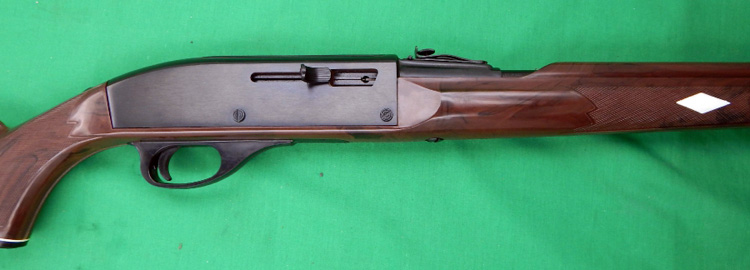
Above pix from the internet and identical to the one I was shooting back
then.
My friend Stewart Callahan of Polkton, NC who also worked at the Anson
Correctional Facility, whereas, we would ramble around shooting firearms and
one particular day in the mid 1980s, he witnessed me shoot 10 out of 10 hand
thrown aerial targets which were dried out black walnuts. Normally, I
could hit about 7 or 8 out of 10, of which I would shoot the Remington Nylon
model 66 .22 caliber LR left handed and throw the walnuts at about a sixty
(60) degree angle upward with my right hand out a fair distance and then
shoot the walnut as it was descending. I believe it was all about
timing and the Nylon 66 rifle was pointing where I was looking when it was
shouldered.
I traded that Remington Nylon 66 to Ram's Sporting Goods in Rockingham,
NC for a Browning semi-automatic .22 caliber rifle and Stewart Callahan
purchased it from them for 150 bucks and he still has the rifle to my
knowledge.
I have seen shooters who would throw a target overhead (vertical) and
shoot it when it momentarily stopped and then make the shot, however I
learned to shoot what I call intercept being more or less instinctive
shooing. I have shot dimes out of the air, but definitely could not
hit them every time.....grin if you must!
Those days of trick aka fun shooting are long gone as with my
youth and thankful for each and every day that God allows. I give God,
the Praise, Honor and Glory in all things through Jesus Christ our Lord and
Savior!
WINCHESTER MODEL 67
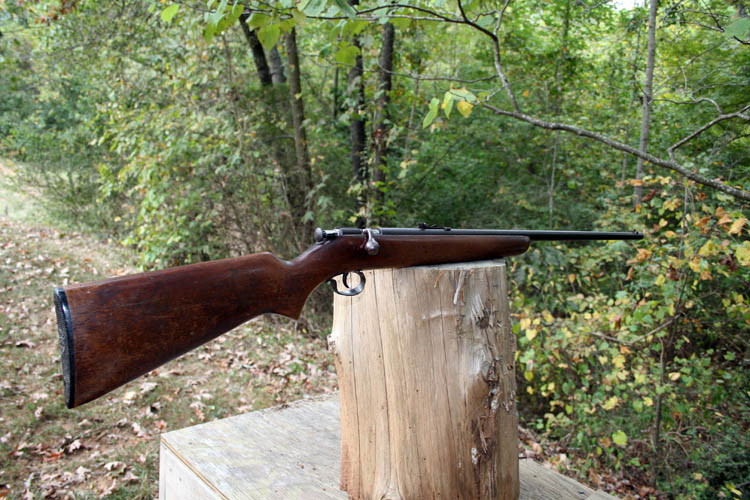
As with most things from the past, our hindsight is 20/20 for sure.
The only rimfire rifle remaining from the past is the Winchester model 67 of
which doesn't have any holes drilled for a scope mount and/or grooves milled
into the receiver section for the same. A good little gun for open
iron sight shooting but with the product of maturity and the date on my
birth certificate, my rifle shooting days with iron sights are long gone and
definitely have to rely on the usage of optics.
The last few years, I got a hankering again to do some .22 caliber rimfire shooting
(going back to my youth days) since the ammunition is fairly cheap but after checking around this year, I found that
the .22 cal. rimfire ammunition was extremely scarce to purchase due to the
consumer
political panic buying brought
about by the current political administrations continued attempt to rid
America of all firearms.
I surmise when you live in a gated community with armed security guards
24/7,
you are not concerned about getting mugged or the threat of experiencing a home
invasion.......
All types of handgun and rifle ammunition is not available
like it once was and the gun shops, etc. are price
gouging the consumer very
badly due to the shortage of rimfire ammunition and all types of handgun and
rifle ammunition although ammunition in .45 ACP and .40 cal. are
beginning to appear on the retailers shelves once again. I ordered a CZ USA
left hand 452 model .22 caliber rimfire rifle but no one could deliver
it in a timely manner and after doing some internet searches, it was found that the Savage Mark
II BTV was a fairly accurate .22 caliber rifle for the price.
SAVAGE MARK II BTVLSS .22 CAL. RIMFIRE RIFLE
I ordered the Savage Mark II BTVLSS in left hand with a stainless bull
barrel and a laminated thumbhole wood stock and was impressed with the
rifle right out of the box as far as looks goes. Their signature accu-trigger was not that
bad either but a little heavier than I remember from shooting the Remington
541-S and had some creep and
grind to it. This Mark II BTVLSS will shoot decent groups at 20 yards
using
CCI .22 cal short CB bullets but it was very hard to get a consistent
group out to 50 yards due to the inconsistency in the loading of the shorts
and these bullets are designed for the gallery and indoor shooting.
My
ultimate goal for this rifle or any other rimfire rifle is to be able to
make clean head shot kills on squirrels out to 50 yards; one shot, one kill!
It should be noted that I am certainly no gunsmith or have
had any gunsmith
training, however I was an armorer for the NC Department of Correction the
last 15 years of my employment but that basically was changing worn out parts replacing with factory
ones and some adjustments would have to be made with various tools, fixtures and
equipment to bring the weapon back to the factory specifications.
I was a Factory Certified Armorer for Smith & Wesson, Ruger and Remington
and an armorer is NO gunsmith!
Upon further checking, the magazine retaining
plate aka (floor plate) that
holds the action to the stock with the larger 5/32 inch hex bolt was very thin; .032 inches thick and would
bend easily when you tightened the 5/32 Allen bolt (stock
assembly screw) down on it. The factory
recommends approximately 18 inch pounds but I don't have a torque wrench and
even snug will bend the thin metal plate. That magazine retaining aka floor
plate is a piece of junk. I ordered an aftermarket stainless steel
magazine retaining aka floor plate from
DIProducts,
Inc. that is a full 1/8 inch thick and it definitely doesn't move
at all when you tighten down on the forward stock assembly screw. Pix below
of the rifle before surgery:
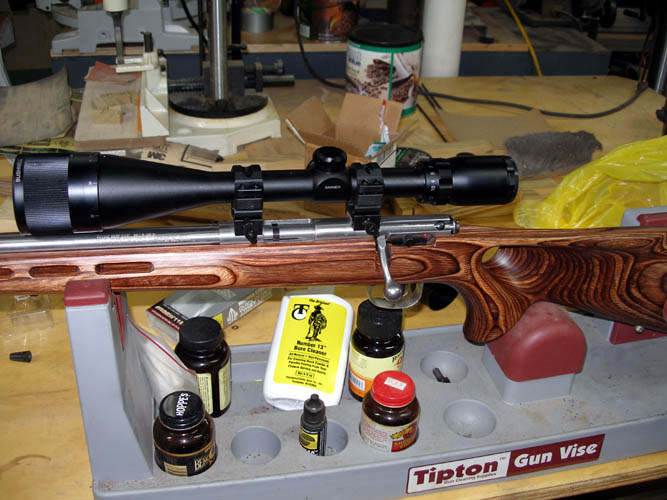
Below are a few pictures and didn't do a sequence shoot since this was
impromptu and I get that way many times...another grin is
in order:
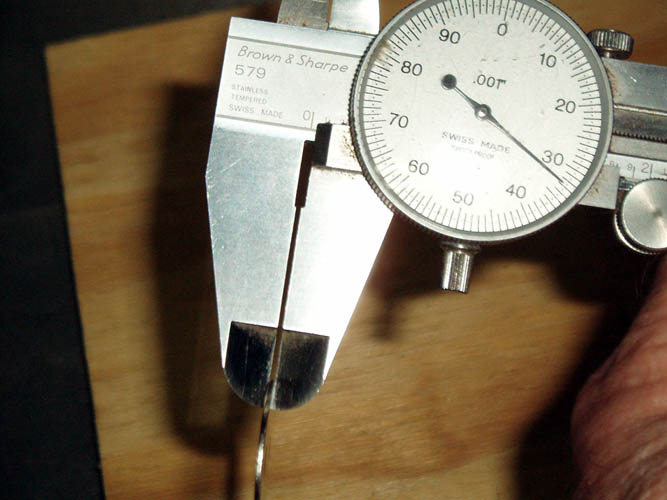

As you can see from the pixs above, the floor plate is super thin and it
will bend with very little pressure exerted. Eighteen inch pounds will
definitely distort it badly!
After removing the barrel/action from the stock, I secured the stock in
my
Tipton
Gun Vise while using a small air die grinder with a flat
base and .032 inch diameter solid carbide two fluted router bit which made
quick work of cutting away the extra material to have the .125 inch thick
DI Products, Inc. magazine retaining aka floor plate to seat flush. The stock at the edge of
the floor plate has a slight radius on the outer most edge but didn't want to
go any deeper for a full flush at those edges. Pixs below:
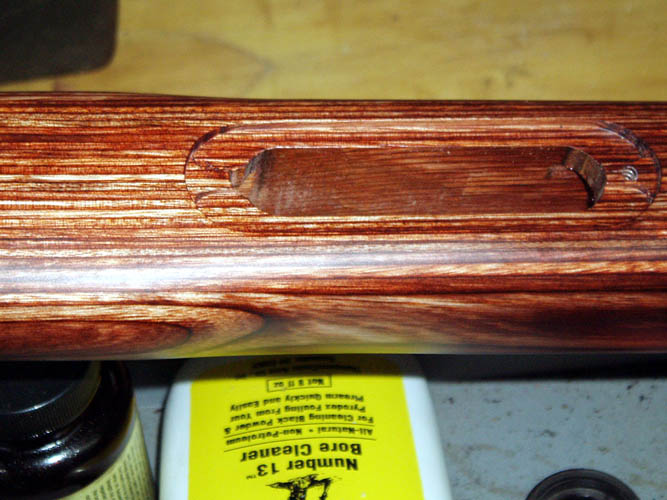
From the above pix, you can see that they left a tab at each mounting
screw/bolt about 1/32 inch above the rest of the stock that was routed for
the floor plate and they could have just as easily routed it full flush....makes one
wonder why they did it that way.
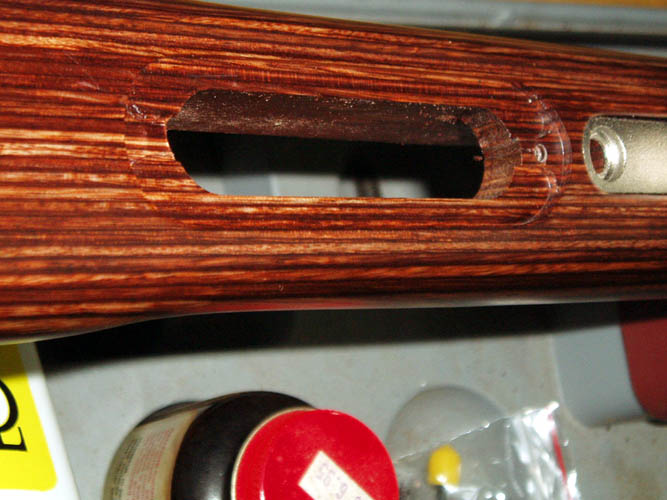
In the pix above, I removed the extra wood on the left side of the floor
plate cavity and later went back and routed the entire cavity to a depth of
.125 inches to match the thickness of the after market stainless magazine
retaining aka floor plate.
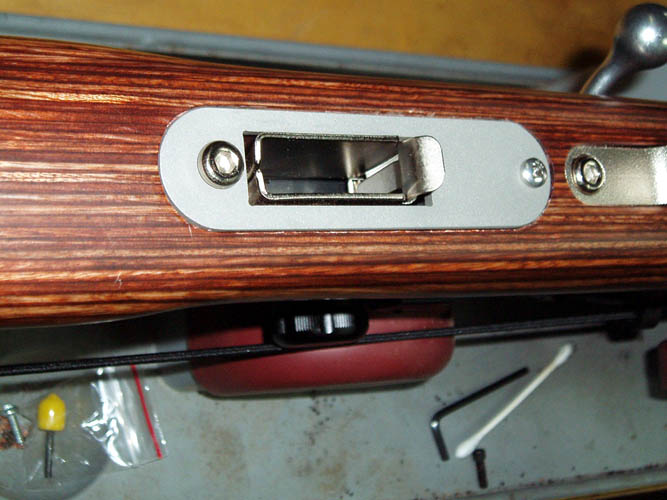
The after market magazine retaining aka floor plate routed fairly flush
with the stock and does not give when applying pressure on the forward stock
assembly screw
on the left. The wood screw installed on the right doesn't effect the
action but merely holds the magazine retaining plate in place when the bolt on the left is
removed along with the stock assembly screw on the trigger guard. Savage recommends tightening the left
stock assembly screw to
approximately 18 inch pounds of pressure along with the forward screw on the
trigger guard. As soon as I purchase a
torque screwdriver set,
(Wheeler Firearms Accurizing Torque Wrench), I will
adjust the stock assembly screws to find the sweet spot
for accuracy!
Below pixs of the air die grinder used to remove the excess wood.
You can see the excess router bit protruding beyond the base which does the
stock removal. I could not locate my
MagEyes 2x magnifier and this
route/inlet job was freehand all the way just with my State eye plan glasses
which leaves much to be desired for close work:
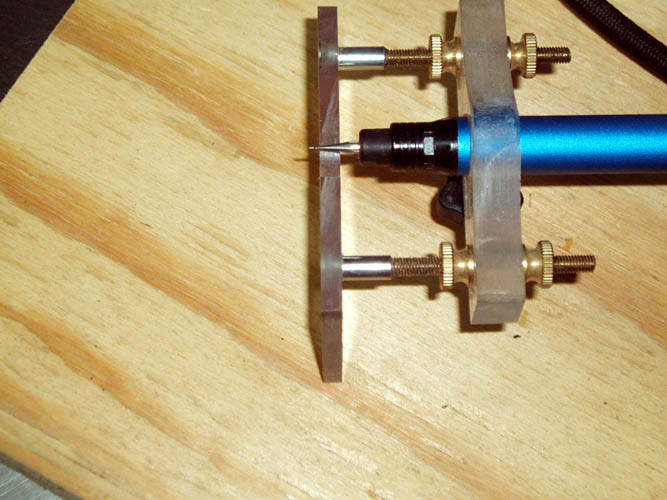
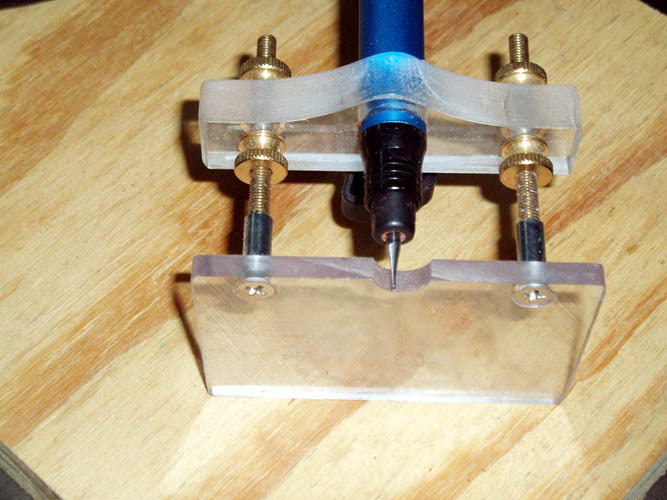
Since installing the after market DI Products, Inc. magazine retainer aka
floor plate, the rifle is shooting much more consistent and will post some
actual groups fired when time permits.
I checked the trigger pull with a Lyman Digital gauge and the
average trigger pull was 2 lbs. 5.8 oz
and one went all
the way up to 2 pounds 15.9 oz. and to get a consistent reading you have to
pull parallel with the bore. Before dry firing the rifle, I inserted a
fired shell casing into the chamber to absorb the firing pin impact onto the
brass instead of allowing the shoulder of the firing pin to strike against the barrel,
although with the recessed rim headspace, it might not make contact with the barrel
but it is better to be safe than sorry.
It is imperative that you place the trigger gage on the trigger for a
straight back pull and parallel to the stock, otherwise you will get
inconsistent readings and most will register on the high side and this
carries over into the actual shooting as well. Finger placement is
critical with the accu-trigger since it is very easy to place the
accu-trigger safety blade into a binding position against the slot in the
trigger due to the "slop" in the design. Click on below thumbnails pixs for a larger screen view:
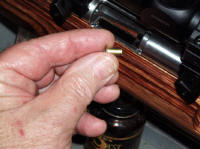
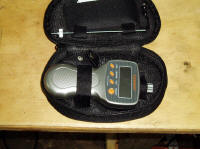
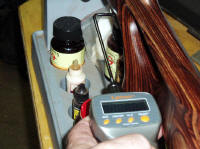
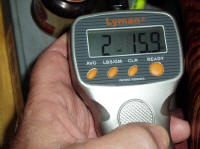
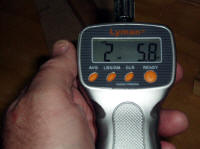
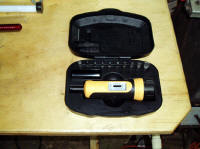
I decided to torque the stock assembly screws to the recommended 18 inch pounds
per manufacturers recommendation, however when I applied more than 10 inch
pounds of torque, I noticed that the receiver bolt had a little
bind in it directly
behind the bolt handle. For such a large diameter barrel, the receiver
appears to be made from a piece of stainless steel pipe or tubing and doubt
it was made from a solid billet of steel. The more I look closely at
this rifle, the cheaper made it looks! The thumbhole laminated stock has a ton of
excess material removed where the entire receiver beds to the stock and the
action bolt lugs that are screwed into the barrel which accept the action
bolts do not contact the stock, only the lower radius portion of the
receiver contacts the inside radius portion of the stock and at the forward portion of the
receiver where the barrel attaches to the receiver and at the rear of the safety
which is probably the reason for the bolt to bind with higher inch pounds of torque applied
on the two action screws that are forward of the trigger guard. It
would make more sense to me to have the stock assembly screws at the forward and rear
portion of the receiver like most of the high powered rifles to evenly
balance out the pressure over the entire length of the receiver itself.
I noticed that the factory had applied just enough torque to the stock
assembly screws to where the thin magazine retaining aka floor plate that held the
forward stock assembly screw did not bend although they recommend 18 inch pounds and if much torque is applied to their factory magazine
retaining plate (forward stock assembly screw), it will certainly bend as I stated earlier. There
just isn't enough material left in the thumbhole laminated stock to install
a forward full bedding pillar but I am sure it can be done and will research
it and
have a qualified gunsmith look into it for me. Both the forward and
rear action lug isn't making contact with the stock at all. When you
are tightening the forward and rear action assembly bolt/screw, you are only
pulling the receiver down into stock.
THIS IS TOTALLY UNACCEPTABLE AND VERY POOR ENGINEERING
AND WORKMANSHIP EVEN FOR A RIMFIRE
UPDATE: On 09-20-13, I checked the distance between the
forward receiver
action stud that the stock assembly bolt/screw screws into and it was about
.040 inches from making contact with the lower portion of the stock with the
receiver flush against the stock. I found a piece of metal bracket
that was a little over .040 inches in thickness which had an elongated slot
at one end and a regular hole punched in the other end and reground one end
to match the radius of the stock and cut both ends of the bracket off and it
worked nearly perfect in the wood stock taking up the slack or gap between
the receiver action stud and was able to torque it at 10 inch pounds
and the bolt did not bind hardly at all. I had to add about .118
inches of spacers between the rear receiver action stud to take up the gap
between the stud and the stock. My
"rube snorkel" shooting rest I am
using is not the steadiest and fired a few 5 shot round groups to see what
the before and after was and I was impressed even with my poor shooting at
20 yards. Below is a scan of the target:
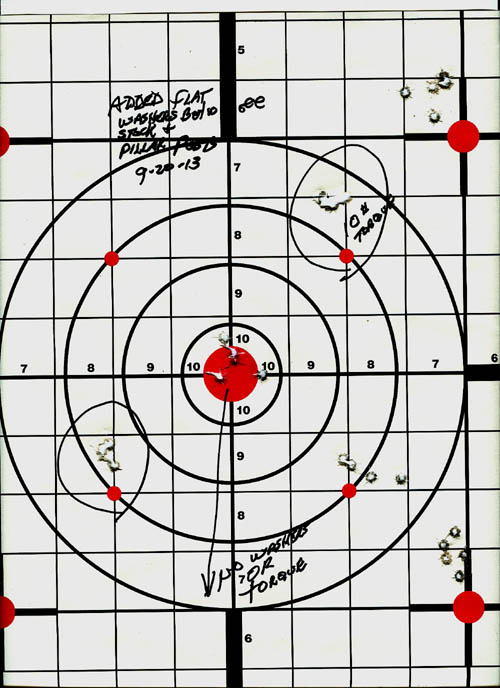
A couple of the groups had all the bullet holes touching and still
shooting the CCI .22 cal. short CB ammunition which isn't that accurate due
to some of the rounds apparently loaded very weakly and they are not
consistent in velocity just by the sound of the report and also the lag in
bullet travel time to the target which is 370 feet per second or more slower than
the speed of sound. With the sun shinning at the proper angle,
I can actually see the bullet come into my line of sight through the scope and then
see the
drop of the bullet into the target at 50 yards.......710 feet per second is
pretty slow for a bullet!
I continued to ascertain why the bolt wanted to bind slightly and the
distance between the rear action stud and the stock cutout was
more than the front distance and added a lock washer over the thin metal
bracket I used to take up the slack and it worked out great. I applied
about 18 inch pounds of torque to both stock assembly screws and the bolt moved like
silk through the receiver and that solved the problem. A first class bedding job would be more
professional but you can't see the washers between the action studs and the
stock so will leave it as is for the time being. I test fired it again
at 50 yards and three of the 5 rounds fired were touching making one hole
and not bad for the inconsistent ammunition.
Below is initial grouping at 20 yards using CCI .22 cal. short CB
ammunition rated at 710 fps and not too bad since I have not shot many
target rounds in the past few decades. The rifle has
promise for sure but my ole Winchester model 67 single shot will group
better than this with open sights:
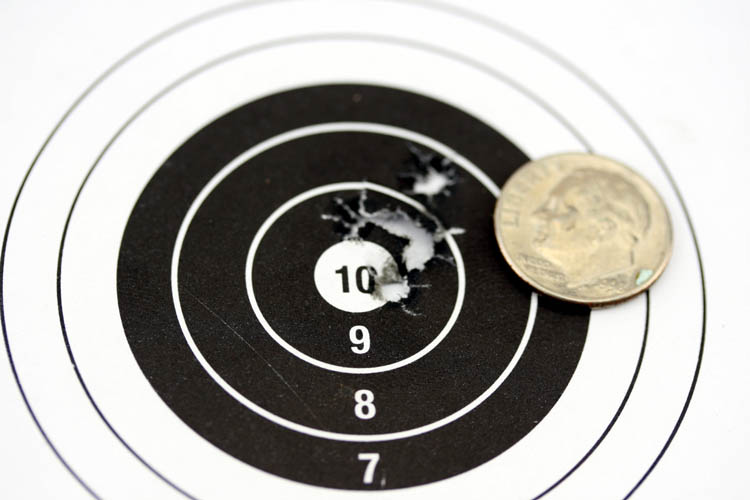

So far, I am not satisfied with the performance (shooting wise) of the Savage Mark II
BTVLSS .22 caliber rifle chambered for .22 Long Rifle but it is feeding the
.22 cal. short ammo without much difficulty. Upon slow extraction, I tilt
the rifle to the left to keep the short shell casing from getting lodged
behind the area of the detachable box magazine. However, you can cycle
the action rapidly and it ejects the spent short shell casing without a problem
and a long rifle or long shell casing
will eject fine either slow or fast cycled.
I might install a short bi-pod on the stock in the very near future to
add to the coolness of the rifle.
I did order and receive a bore guide # 175 machined from a solid delrin
rod from
Possum Hollow Products, Inc. which fit the receiver perfectly..........an
awesome first class all American precision manufactured product. Pixs
below:
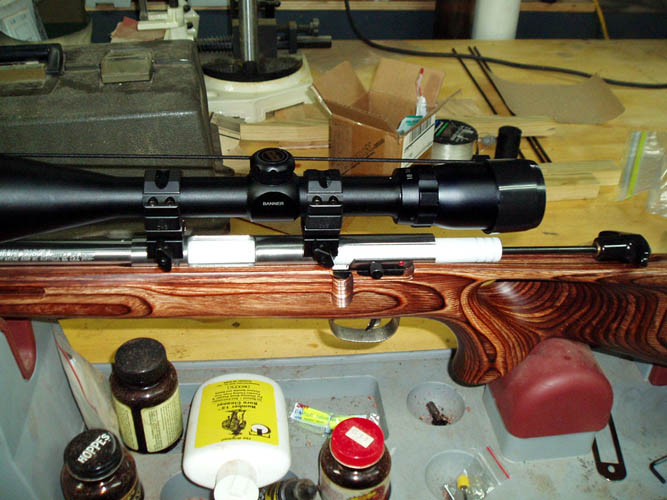
I have since updated my Kleen-Bore one piece stainless steel coated
cleaning rod to a
Pro-Shot
highly polished one piece stainless steel rod.
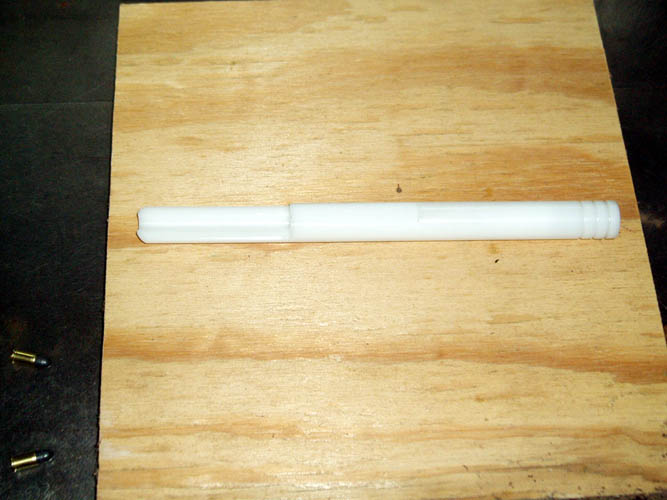
When I get a chance to really dial the rifle in, I will post additional
target groups fired. I am sure the rifle will fire the long rifle
ammunition with much greater accuracy but enjoying the low signature report
of the shorts.
Web published by Bill aka Mickey Porter on 09-09-13 with updated pixs
added on 09-20-13.
INGREDIENTS FOR A SQUIRREL STEW
Since our annual squirrel season came in, I have ten (10) or eleven squirrels
ready for a Squirrel Stew.
There were several squirrels consuming my shelled deer corn this afternoon
and had a chance to "nail" a couple of them at about 50 yards.

Web published updated pix by Bill aka Mickey Porter on 11-25-13.
SAVAGE MARK II UPDATE 12-29-13
I ordered Capt. Robert Webster, retired NCDPS a 1/8 inch thick
replacement Bottom metal plate for his Mark II blue bull barrel rifle and we
installed it this afternoon. We also fired a couple 20 yard distance 5-shot groups
using CCI .22 cal. Short CB rounds and both our groups were pretty good.
Robert did an internet search while here and reviewed several ways to drop
the poundage on the Accu-trigger since his trigger pull was registering 3
lbs. 14 oz. although the gun is advertised to go down to 2.5 lbs. of which
his was adjusted at the lowest setting.
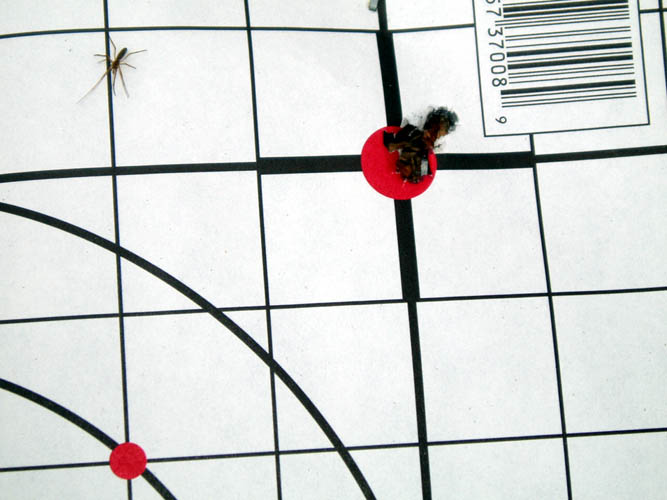
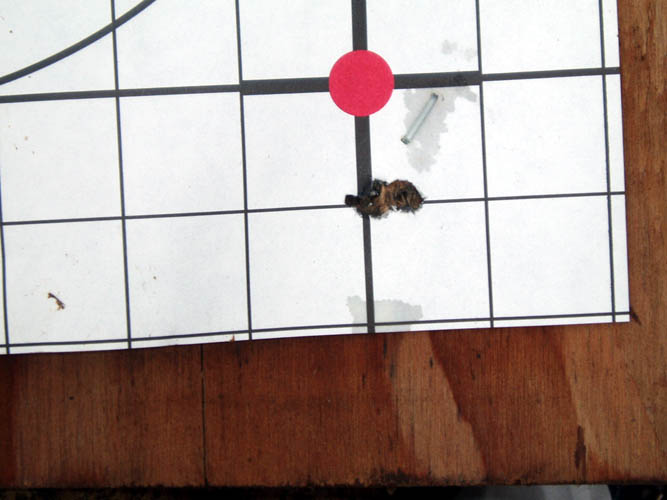
Robert shot the smallest 5-shot group on the right which was about 1/4 x 1/2
inch....awesome for shooting off a poor rest. Robert had his rifle
dialed in for the .22 cal. long rifle sub-sonic loads which are inherently
more accurate but I am opting for the much quieter muzzle report at the
moment but will later test fire the different brands of long rifle
ammunition to ascertain which brand will yield the most accurate and
consistent grouping. My rifle is dialed in for the CCI .22 cal. Short
CB rounds with the POA (point of aim) pretty close to centered whereas
Robert's POA is one inch lower with the Long Rifle sub-sonic rounds. I
certainly don't plan to purchase any of the high dollar Eley Tenex, Aquila,
Lapua or
other extremely costly target rounds since I am convinced this rifle will group
accurate enough for my small game plinking and informal target shooting with
the CCI .22 cal. Short CB rounds but I do plan to take it to the next level
when my silencer application gets ATF approval.
Robert and I finally decided not to remove any coils from the main spring on the
trigger since it has a right angle bend on the larger coil spring end that
rests into a hole in the trigger group housing to keep the spring in place and
it would be difficult to cut the spring and then try and bend the tempered spring
back at a 90 degree angle without heating the spring which could ruin the
temper of the spring. We viewed one
video clip that ground off part of the trigger base than contained the
terminal end of the spring which would accomplish the same thing.
While Robert was getting his trigger housing removed and taken down, I stated,
"If it don't work, you ain't messing
with mine".......Robert
looked at me and we both grinned like a possum
eating persimmons and he said
"I was
thinking out loud." The spring's terminal has a much smaller diameter
and is housed in a hole that has screw treads which allows you to move the
compound wound spring up and down to increase or decease the trigger tension
and the removal of additional metal from the top of the trigger support area should not
effect anything else and still give you the capability to increase the
spring tension if necessary.
The only tools needed was a flat base abrasive wheel, a small router
(Dremel), small flat screwdriver, flat Bastard file and Allen wrench set of which I had the
items. Once the trigger assembly was removed from the receiver, the trigger
was removed from the trigger group housing by removing an E clip and pushing
the retaining pin out. The trigger was secured
in a flat drill press vise and clamped to my table saw metal table for
additional support. Click on below thumbnail pixs for a larger screen
view:

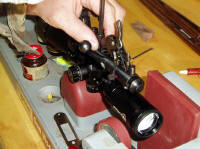
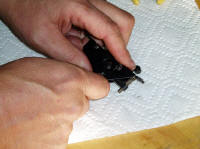

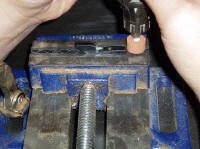

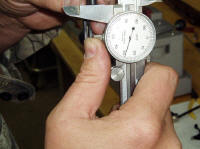
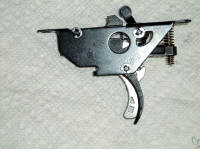
The height of the trigger area that supported the lower portion of the
spring before grinding on Roberts trigger was .303 inches and reduced to .228 after
grinding (about two coils strength reduction) yielding a 2 lb. 3 oz. trigger pull and very smooth. Robert
ground my trigger down and he sounded like a Dentist
on Steroids and had sparks flying everywhere since he
bolstered his confidence level after grinding the first one down. We both got a
good grin off that for sure. Each of us fired a 5-shot group afterwards but the
wind was blowing pretty fast and we didn't shoot as tight a group due to the
wind.
We are very pleased with the reduction in the trigger poundage on both
our rifles and with
the right combination of ammunition and a much steadier professional type
bench rest both front and rear, I am expecting some decent groups at 50 yards.
A RIFLE THAT COULD BE MUCH BETTER
With the price of the Savage rifles, Savage could do a much better fit
between the action and the stock since programmable CNC routers do all the work
capable of hitting their programmable mark within a few thousands of an inch and also
replace the Elcheapo bottom plate which is a piece of junk. I would be
shooting the CZ USA Model 452 .22 cal. rifle but no one could supply one in a
left hand model in a timely manner although they are advertised for sale but on back
order. However, accuracy reports place both rifles about the same but
the CZ USA doesn't have the stock and trigger issues above or not reported
anyway. Those that
have "tricked out" their Mark II
have very positive things to say about them as far as accuracy goes. I
have looked at the possibility of putting pillar blocks in the stock but the
main problem is with the forward action lug, the stock is hogged out
to where there is barely enough wood and the only real contact was between
the outside of the receiver and the forward portion that is away from the
hogged out area which has already compressed several thousands of an inch.
Placing a pillar block at the trigger guard would not be that much of a
problem since there is enough wood but you would not want to use a standard
1/2 inch diameter pillar block either and more or less around 3/8 inch
diameter which would still allow you to make metal to metal contact from the
receiver. I am researching what others have done to the BTV stock as
far as bedding and pillar blocks with mixed opinions at the moment.
I am somewhat pleased with the Savage Mark II BTVLSS and believe it is
going to make a serious squirrel gun once I get myself dialed in to the rifle with
the right amount of "perfect practice makes
perfect." I know what you are thinking, Practice
makes Perfect but if you practice something wrong, you will be proficient at
doing something wrong, therefore "Perfect
Practice Makes Perfect."
Web published update on 12-29-13 by Bill aka Mickey Porter.
STILL TINKERING WITH THE ACCU-TRIGGER 12-30-13
Being retired, I do have the opportunity to do fun things more often and
decided to take the trigger pull down a little further on the Savage Mark II.
Pretty much the same thing as described above but used the flat Bastard file
instead of the Dremel tool and stone. Below a few pixs to document the
event:
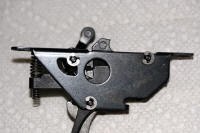

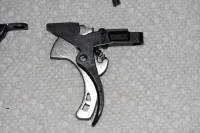
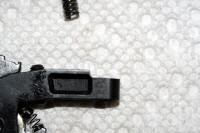
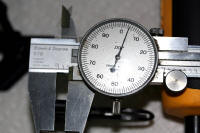
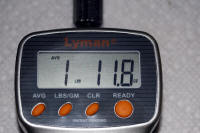
I was pleased with the results getting the trigger pull to average
1 lb. 11.8 oz. and it really felt light
but still had a little grind and creep and will test fire it this afternoon. I checked the safety
mechanism and also tried to disengage the sear by hitting/jarring the rifle
stock pretty good with the safety in the off position and the sear would not
release and that is definitely what I wanted to know.
As evidenced by the above picture, I filed the rear trigger portion down
that houses the trigger main tension spring to a little over .2035 inches
from the .228 that it was ground down to yesterday. The original
factory height of the rear trigger portion was .303 inches with around .100
inches removed. I plan to leave the trigger as is and concentrate on
improving my shooting technique. Below the best 5-shot group fired at
20 yards with the action bolts aka stock assembly screws at 18 inch lbs. of torque. I was throwing
rounds all over the place this afternoon and passing some blame on the
ammunition....grin if you must! Below group .435 outside
to outside (.213 center to center) and will harvest small game but I plan to do much better with a
more stable front and rear rest/bag. The below group is what I desire
at 50 yards but it is going to be tough to do with this rifle for sure:
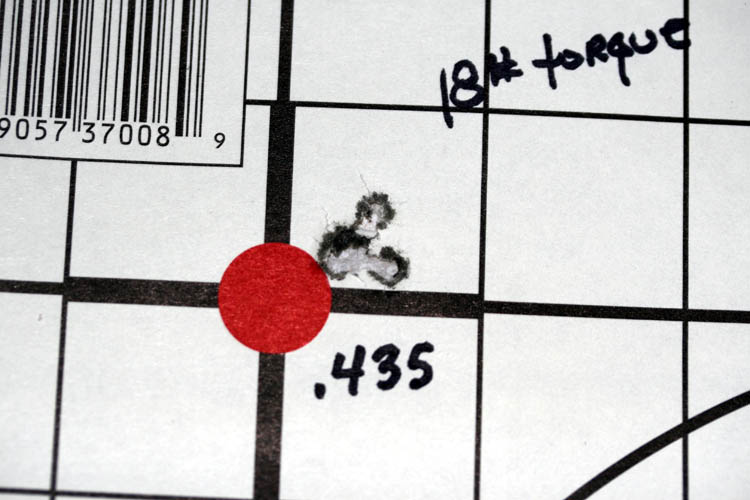
Many years of not doing any target shooting and plinking, other than
firing a few rounds each year to harvest venison for the freezer and an
occasional squirrel or rabbit harvested with the little Winchester model 67
open sights, time and age appears to have taken it's toll which might
not be a valid excuse. I am certainly having fun trying to get where I
can shoot much better without spending a ton of money on a special race gun
just for plinking with a rimfire rifle again.
As good as the Savage Mark II BTVLSS is, my ole Remington 541-S and the
1960s Sears & Roebuck made by Springfield (which I no longer own either) would definitely
out group this
rimfire rifle. However, it just might be the shooter in this case
having consumed too many barrels of leaded coffee aka Ole Joe, Java, etc. over the
decades and on the NC
State Eye Plan Glasses and not the rifle........grin
if you must!
Web published update on 12-30-13 by Bill aka Mickey Porter.
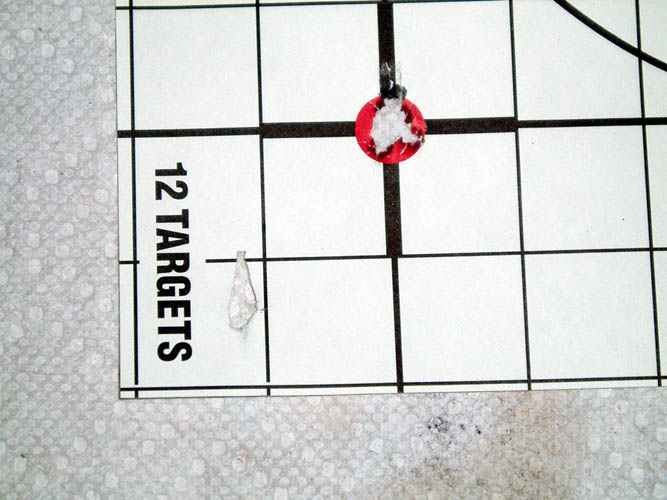
I shot a few of the CCI .22 cal. Short CB rounds 01-04-14 at 20 yards and
no steady rest yet, however I moved the scope power down to 9X and that took
some of my perceivable movement
and shake out...............way too much leaded coffee today.
I have a
Sinclair Heavy Varmint AP Windage Rest Left-Hand # 749-013-852WS and a
Protektor B. B. Leather 55AC Rabbit Ear Loaf Rear Bag on order and this
should improve my shooting since the rifle is moving and not steady with the
Rube Goldberg homemade stuff I am currently using. I have viewed
several permanent and portable
shooting bench rest tables and plan to construct a
heavy duty one and hopefully remove as many of the variables, whereby
concentrating on improving my shooting. Both items are on
back order and hope they will be delivered before too much longer.
Check my portable
shooting bench out that I built and waiting on the weather to dry out
and apply a coat of oil stain on it.
My goal is to be able to make consistently clean head shots on squirrels
out to 50 yards (if necessary) and don't think it will be a problem since I have nailed
quite a few of them already at that distance but not with every shot and blame
the ammo and mostly the shooter's current skill level but I guarantee you, it
will get much, much better.
If the rifle will not do that, it will make someone a good boat anchor
for sure and will have to spend some serious upgrade bucks but I have not given up
yet on this project and "The Jury Is Still Out." I
have vented verbally and physically before with products that did not meet
my expectations that the factory didn't correct after phone calls and
emails. Below is pix of an 800 dollar PSE Mach6 bow that was their
"flagship" bow in the mid 1990s and I solved the problem, even though
unorthodox and to the extreme:
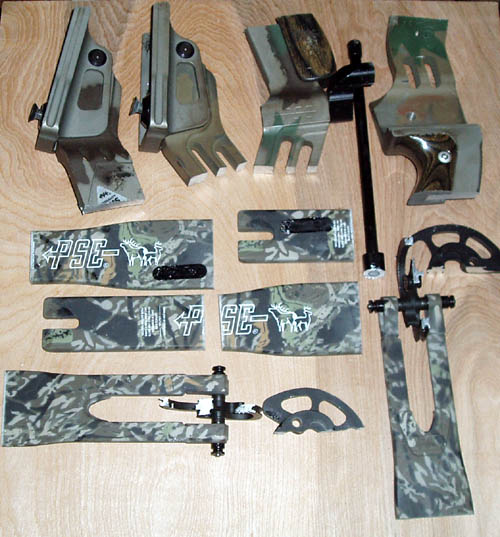
Read my short story titled
Murphy's Law.
I believe the above action voided the warranty on that
bow!
Web published update on 01-11-14 by Bill aka Mickey Porter.
REAR PILLAR BLOCK INSTALLATION 01-23-14
After surfing the web and looking at what others have done to their
Savage Mark II BTVLSS and other Savage similar model .22 caliber rimfire rifles, I
decided to go with just pillar block bedding the rear action lug to start with.
The problems I noted on others that have pillar bedded their Savage Mark II rifles, the
front pillar block installation has not held and there just isn't enough
room in the stock to surround the pillar 360 degrees, only about 270 degrees
at the most which is not good. The Savage stock that I have is
probably one of the worst that I have seen as far as having receiver
to wood stock contact.......the stock is just hogged out far too much.
It looks like their
CNC router got a mutant virus or
hired a starved beaver who went crazy chewing up the wood stock blank not knowing when to stop
gulping down and slinging wood chips.
As noted in this short story, I had already placed .118 thousands of inch
spacers between the rear receiver barrel stud that terminates the action screw
aka stock assembly screw so
there would be contact between the receiver stud and the stock which worked
ok but wanted to fix something permanent that would not allow the wood to do
any serious compression. The front receiver action lug required around
.040 thousands of an inch to make contact with what wood there was between
the stock and the magazine aka floor plate. I found an old Waverly routing guide for a
Dremel tool that had not been used since the year 2000 and decided to
recycle it since it had two posts that were .375 inches in diameter and
drilled and tapped for a 1/4 x 20 bolt and the head was plenty long enough
to grind down to the exact length required to fill the above space between
the rear receiver action stud and stock. The action screws are .212 in
diameter and
1.25 inches in length and will fit through the 1/4 x 20 tpi inside
diameter of the brass bushing with some clearance. Pix below of the router jig
cannibalized.
NOTE: This is not the actual Dremel router
jig I cannibalized but one from Stew Mac's website since I didn't take a pix
of mine before the cannibalization.
Pix below of the Stewart MacDonald router jig for the standard Dremel
tool from their on-line catalog:
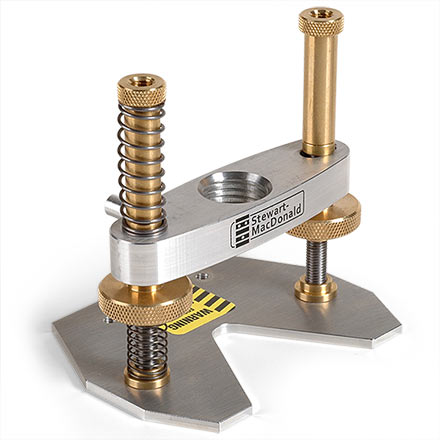
Below pix of my Stew Mac router jig after cannibalization. The base portion
was in my Dremel accessory case:
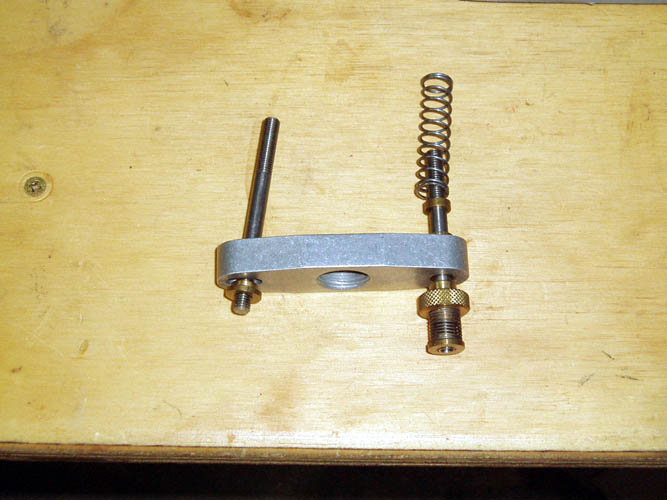
Robert Webster and I bedded his rear action screw and the space between
his stock and receiver rear stud was .215 thousands of an inch and used an
additional flat stainless steel spacer which we probably didn't need,
although it would help disperse the tension created. Pix below of his
spacer and brass bushing aka pillar block. Since there will be metal
to metal contact between the receiver rear action stud, the brass bushing
aka pillar block and the metal trigger guard, the brass will hold up fine.
Don't believe any exotic metals needed here! Pix below of Robert
Webster's Mark II BTV stock with the spacer and brass pillar block
installed:
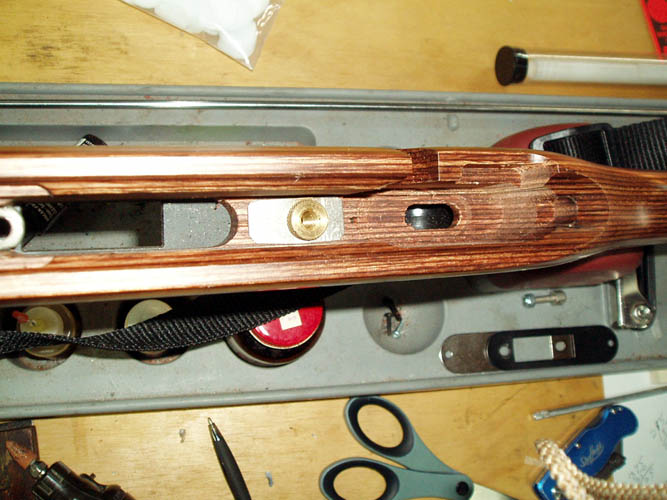
Robert and his Savage Mark II BTV were the guinea pigs on the pillow
block bedding and didn't take any sequence pixs. That afternoon, I decided to
go ahead and pillar block my rifle and took the time to take some sequence
pixs. The first order of business was removing the barrel/action and trigger
guard. I used a .250 diameter drill bit to align the stock with the
chuck and then drilled out the rear action screw hole to .375 inches in
diameter. The head of the brass bushing was ground down to .120
thousands of an inch plus or minus and then placed into the stock and scribed around
the back side of the bushing flush with the stock that was recessed for the trigger guard.
I cut the bushing to length and then ground score lines around the outside
perimeter of the bushing to help the epoxy adhere a little better. The receiver and
barrel was placed back onto the stock for a trial fit and everything looked
good. I waxed the rear action screw and the trigger guard that will make
contact with the bottom of the brass bushing aka "pillar block" to prevent a
lock-up. Epoxy aka JB Weld was placed on the bushing and placed back into
the stock and cleaned any excess epoxy from the trigger guard area and
reinstalled the trigger guard and both action screws applying 18 inch pounds
of torque to them. It probably would have been better to secure the
barrel/receiver to the stock after tightening the action screws just enough
to have everything aligned and use only rubber bands to hold in place until
the JB Weld cured out. This procedure would prevent any torque to the
receiver to the pillar blocks. Click on sequence thumbnail pixs below for a larger
screen view:

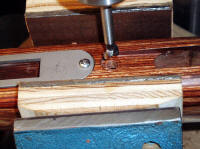
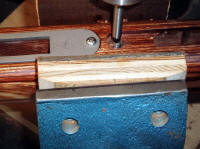
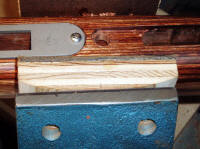
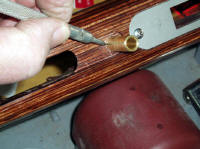
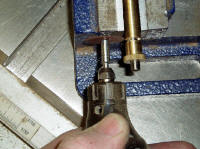

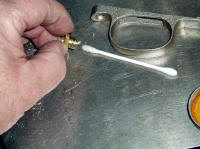
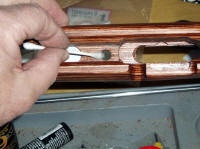

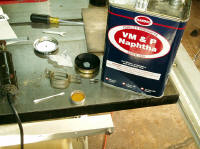
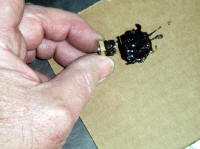
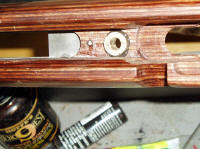
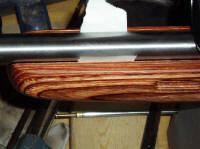
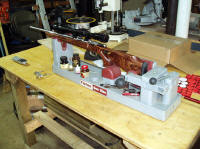
After the J B Weld epoxy sets up overnight, will check and see how it groups but the weather
has been very windy, cold, blusterous and not conducive to do any serious shooting but
will fire a few rounds anyway in the afternoon. Nope, changed my mind!
Robert Webster and I plan to epoxy aka glass bed the forward portion of the
receiver and about an inch or so of the barrel since that basically is the
only part of the receiver action that is making any serious contact with the
wood stock and the stock portion that is making contact with the receiver
is minimal. The forward receiver action stud with the wood hogged out
underneath and around the stock assembly action screw hole is the weak link and the bedding should
reinforce and stabilize this weak area. There is a few thousands of an inch depression in the wood stock
from the front portion of the receiver when we received those rifles since
there was a gap between the forward action lug and rear receiver action lug and the
receiver was pulled down hard into the stock and bending the thin
magazine aka floor plate which we corrected that. Only a small amount
at the rear tang side wall of the receiver makes contact with the stock any I think it might be free
floating a few thousands of an inch or two since we added the spacers,
whereas the side of the receiver makes minimum contact with the wood stock.
As the ole saying goes, "The proof is in the taste of the pudding" and in
this case, the shot group will be the taste test!
NOTE: It would have been much easier and more precision if I
had a metal turning lathe of which I haven't owned one in years and also a
milling machine, therefore had to use what basic machinery and tools at
hand. Standard adjustable pillar blocks available at Brownells and
other suppliers are .500 inches in diameter and a little large in my opinion
for this project since there isn't much wood on the Mark II BTV stocks,
especially for the forward stock assembly screw.
I ordered Devcon Plastic Steel Putty # 10110 to do the receiver bedding and
it should be here within a few business days.
PREP WORK PRIOR TO BEDDING THE RECEIVER 01-24-14
In the meantime, I went ahead and prepped the rifle for the receiver
bedding job. I roughed up the areas of the stock that makes contact
with the receiver with the Dremel tool and checked that I have adequate
clearance between the barrel and the stock. Below a few pixs taken:
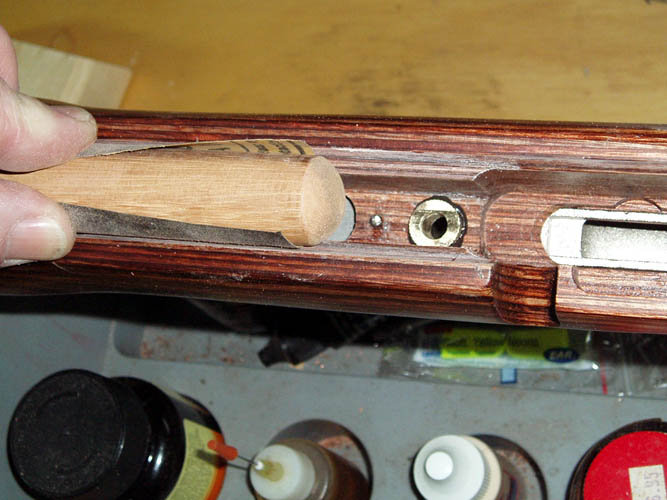
As evidenced by the above pix, the receiver makes very little contact
with the wood stock, only the perimeter of the receiver; nothing like the
receiver of a Remington 700, etc.
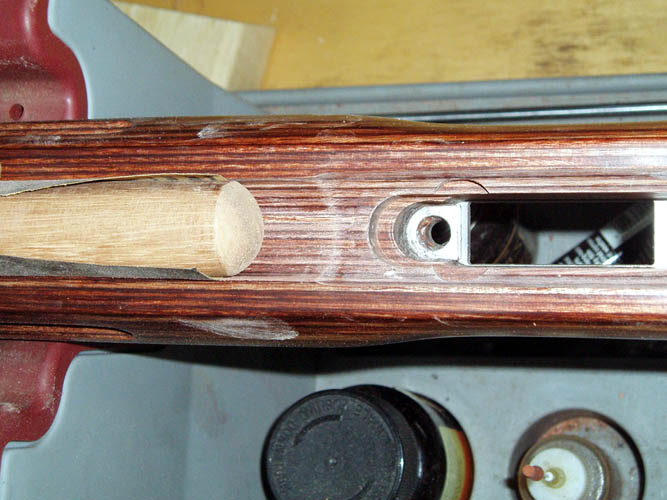
You can see the depression/indentation in the wood stock in the above pix of the most
forward part of the receiver that makes contact on the lower portion of the
receiver. The wood stock even though laminated is very soft and easily
compressed.

I removed a small amount of wood from the sides of the stock that makes
contact with the receiver to help the Devcon "mud" adhere better.
I smoothed up the upper edge with a round wooden dowel and 100 grit
sandpaper. In the close-up pix below, you
can also see the forward action screw (stock assembly screw) area
below the washer that is totally void of wood to
give 100 percent support for the receiver action stud. This is about
as bad as it gets. There is simply not enough room to properly install a
forward pillar block surrounded with 100 percent wood contact, maybe 50
percent
contact only! There might be 3/16 inch forward ledge that
supports the lug with the area to the right nothing but space! I will
install a hollow spacer to fit between the fabricated metal washer that sits
on what wood there is to support the receiver action lug prior to bedding
the receiver.
The video clips and threads that I have viewed showing adding a pillar
block to this rifle for the forward action screw has failed because there is
not enough wood to totally contain and surround the standard 1/2 inch
diameter pillar block.
WHERE'S THE WOOD?
I get extremely irritated every time I see
how much excess wood was removed from this stock. The only reason I can
think of Savage using such a stock design is because of the magazine wells forward slant design
needing the extra room but that is no
excuse. It would
have been better to have a straight magazine well
with complete wood
contacting the forward receiver lug allowing for a standard pillar block
installation. For this reason only, I definitely would not purchase such
a piece of junk if I had to do it over again! Looks pretty on the
outside but a different animal when you open the paper bag. I realize
this is a 400 dollar plus rifle, but I certainly did expect more bang for
the buck than this poorly and ill fitted stock.

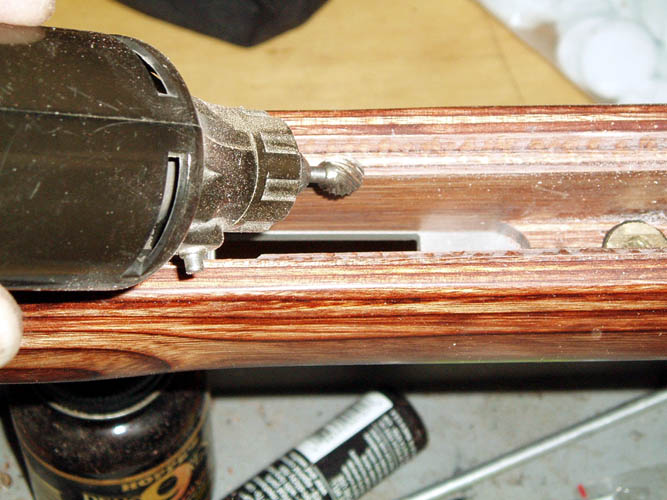
The little Dremel tool is on its last leg of usage with the ball bearings
beginning to cry out...Help Me, Help Me........only been used off an on
since the late 1960s and have repaired it a couple times. I think the
new ones have sleeve bronze bushings instead of sealed ball bearings.
Below pixs of getting a hollow filler spacer put in place below the front
receiver action lug.........as I have stated many times already, there just
isn't enough room to put a regular size pillar block for the forward action
screw and this should work filling the gap between the wood and the magazine
aka floor plate. I continued to cannibalize parts from the router base
and drilled out a thumbscrew that was within a few thousands of being the
perfect thickness. I drilled a hole larger than the action screw for
clearance and it is smaller than the hole in the magazine plate. I cut
the brass spacer in half using the Dremel tool with a friction cut-off wheel.
I used a drill bit and wrapped with a couple turns of Teflon tape for a
tight fit and inserted it through the hole in the magazine plate through the
existing hole the factory drilled through the wood stock and the steel
custom washer I had installed earlier to make contact between the receiver
front action lug to the wood stock. I then mixed up some JB weld epoxy
and filled the gap and inserted the half brass bushing since that was all
that would fit in the hogged out factory cut wood stock. After the
epoxy cures overnight, I will hopefully be able to remove the drill bit
inserted.....grin if you must!
Click on the below thumbnail sequence pixs for a larger screen view:
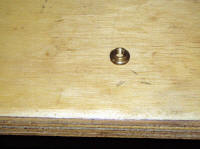
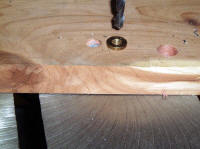

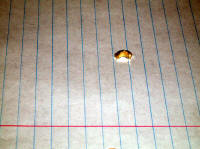
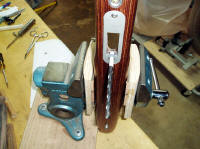
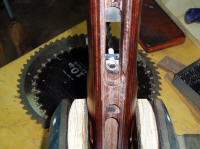
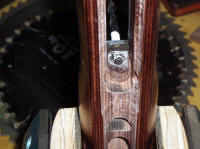
NOTE: Some of the thumbnail pixs were deleted and not
recoverable.
Below are pixs of the barrel and action both top and bottom view and you
can see there isn't much of the lower portion of the receiver that actually
makes contact with the wood stock, only the lower outside portion only and a
small amount of forward section where the barrel joins the receiver.
After the JB Weld cured overnight, I placed the barrel/action back onto
the stock and tightened the stock assembly screws to 18 inch pounds and I
had clearance between the entire receiver and barrel, of which I have
adequate room for the Devcon Plastic Steel Putty to fill in the area between
the receiver/stock and also about an inch or more of the barrel at the
receiver end for additional support and stabilization.
Like I have said many, many times on this website, "Most of the time,
you get what you pay for." Should have spent a few thousand
bucks and got a real .22 caliber rimfire tack driving rifle, but then again,
I would not have had so much fun messing with this rifle...............grin if you
must!
Web published updates on 01-23-14 and 01-24-14 by Bill aka Mickey Porter.
RECEIVER BEDDING 01-28-14
I received the
Devcon Plastic Steel Putty # 10110 yesterday and decided
to bed the receiver this morning since the weather prophets are calling for
ice and snow this afternoon with a winter advisory warning until 9AM
tomorrow and a good day to stay inside where it is warm and dry. I started by cleaning the wood stock again with Naphtha and
a Q-Tip and let it dry; very minimal amount of Naphtha. The metal parts that make contact with the
stock was waxed with a coat of Kiwi Neutral Shoe Polish and then buffed it
down some with a paper towel. Plumber's Putty was applied around the
areas that could possibly cause a lock up and it took several times of
trimming excess putty off so the action would make contact with the wood
stock and not have any Plumber's Putty contacting the wood stock that will
have the bedding compound applied. I then cleaned the wood stock again
and let it dry a few minutes and applied another light coat of Kiwi shoe
polish to the barrel/ receiver. The Naphtha dries very fast and in the
meantime, mixed up a small amount of the Devcon Plastic Steel Putty using a
2.5/1 ratio of the putty to hardener. I mixed the steel putty thoroughly and applied
it sparingly to the stock areas making contact with the barrel/receiver and most of the bedding material
was underneath the
front portion of the receiver lug area and a good one inch of the barrel. As
evidenced by the pixs taken below, there is very little metal to wood
contact with this stock.
I placed the barrel/action carefully back onto the stock and everything
aligned very well and pressed the action in place of which the Devcon
bedding material oozed out and then torque the action screws to 18 inch pounds pressure
and excess bedding material was observed all around the action which is desired. There
was good free floating barrel clearance and cleaned the excess bedding
material that had oozed out between the receiver and stock. There
should be stress free bedding between the action and stock. Some will
allow the bedding material to get partially hardened depending on the cure time
before they start removing the excess bedding material. I used
many Q-Tips and a light application of Hoppe's # 9 solvent to the tip of the
Q-Tips which worked
exceptionally well. Having worked with epoxy for many years with
musical instruments, you have to clean the excess up quickly depending on
the specific application.
The
acid test
will be tomorrow when I "remove" the barrel/receiver from the
stock and hopefully there will be no mechanical lock-up. My friend Robert Webster
who is the next candidate to bed his Savage Mark II rifle, said that we could always use a
hammer and chisel if necessary to remove the barrel/receiver from the wood
stock and we both got a good grin off that statement for sure.
We also laughed out loud since I was the
guinea pig this time on the receiver
bedding.
NOTE: Thumbnail pixs were deleted and not recoverable!
I drilled a one inch diameter hole in a scrap piece of 2 x 4; clamped in
a vise and inserted the rifle barrel to allow the Devcon Plastic Steel Putty
to cure out
with the rifle inverted in case the putty decided to gravitate of which I
don't think so due to the consistency of it. The pot life is about 45
minutes at 75 degrees F. and fully cures in 24 hours.
As soon as the weather is agreeable, I plan to test fire some subsonic
LR ammunition and see how the rifle groups at 50 yards and will post the
results in the near future. I don't have any of the
"good stuff" ammunition yet, but will test what brands
of ammo I do have.
Web published update on 01-28-14 by Bill aka Mickey Porter
RECEIVER BEDDING CONTINUED 01-29-14
I was a little antsy with anticipation waiting for the Devcon Plastic
Steel Putty to fully
cure and sometime mid-morning I loosened the stock assembly screws aka
action screws and had a little difficulty in getting the barrel/receiver
from the stock. There was a small mechanical lock-up where the barrel
adjoins the receiver but persuaded it to break free. Everything looked
good and the Devcon putty set up solid as steel..........no pun intended..........grin if
you must!
It took a good amount of time to fully remove the Plumber's Putty from
the receiver and dressed up a few rough edges on the lower part of the
inside of the stock with a rasp. I plan to reseal the inside of the
stock with sealer to help prevent any moisture absorption. There is a
glove fit between the stock and action and the Devon liquid steel putty
didn't show any evidence of shrinkage that I could visually see.
NOTE: Thumbnail pixs were deleted and not recoverable!
When the weather breaks, I plan to do some test firing and will post the
results here. I am well pleased with the outcome of this bedding job
which was my first but have done much musical instrument inlaying of mother
of pearl, etc. many decades ago so did have a little similar experience
although this was a whole new ball game for sure. I certainly wouldn't feel bad
paying a top notch gunsmith to bed an action for me considering what could
easily turn into a very bad experience if not done properly.
NOTE: On 01-30-14, I removed the Plumber's Putty from the
hole drilled in the stock that is located about 1 inch forward of the
receiver that had the Devcon "mud" applied..........don't have any clue why
the hole is drilled there other than stock weight reduction. I cleaned
and roughed up the area inside the hole with a small router bit in the
Dremel tool and filled the cavity with J B Weld epoxy and let it cure out.
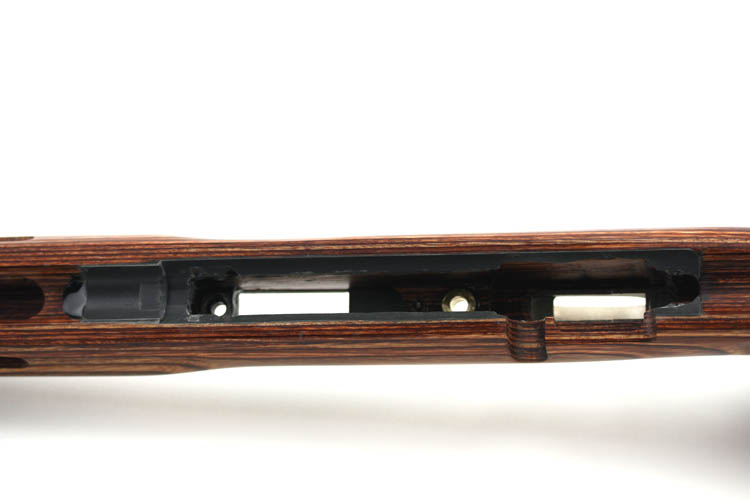
NOTE: 03-25-14 I got the ole Dremel tool out and ground the
portion of the Devcon Steel bedding that is about 1.25 inches ahead of the
receiver bedding area to full float the barrel. Below is a pix of the
barrel full floated. I test fired it on 04-01-14 and it did group
better, however I had a problem with loose base mounts to the receiver but
full floating is the way to go. Prior shooting data with the scope
base mounts compromised earlier will be more reliable in future test firing.
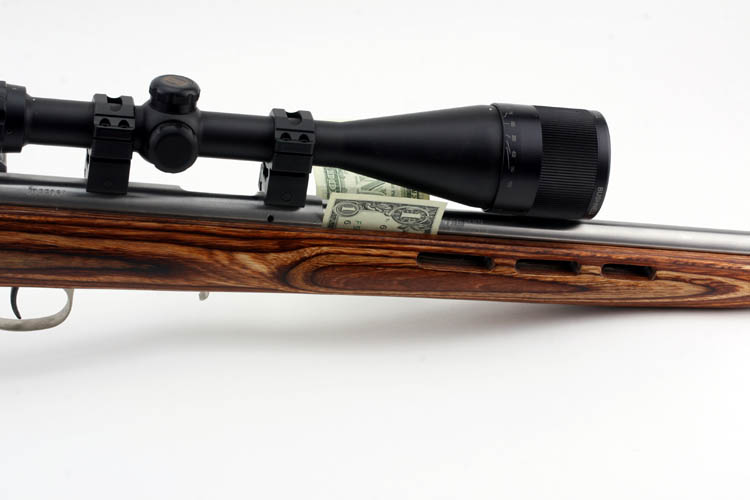
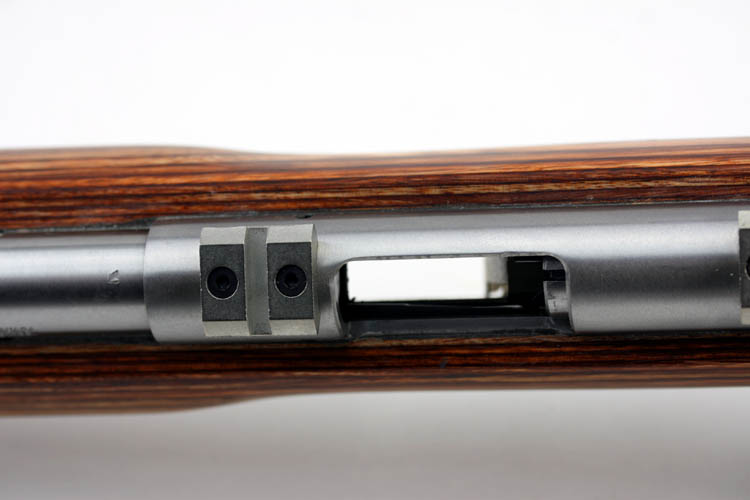
In the above pix, you can see the Devcon Plastic Steel Putty between the
barrel/action and stock which is what I was after.
Next on the list will be to watch my friend Robert Webster bed his Savage
and see him "sweat" and "squirm" a little.
Robert came over this afternoon around 4ish and we started bedding his
Savage Mark II. It was fun to rib him about taking a good shooting
rifle and the possibility of messing it up turning it into a boat anchor..........we both grinned out loud.
NOTE: Thumbnail pixs deleted and not recoverable!
It didn't take too long to have the rifle ready for the Devcon "mud" and
after a clean-up, the rifle was placed in the holder in the vise to cure out
until tomorrow afternoon. I told Robert that was when the fun begins
and hopefully want have to beat the receiver loose from the stock with his
proverbial "hammer and chisel", payback is sweet!
Also mentioned the usage of a oxy/acetylene
torch to add to his own personal anxiety..............I know that was
bad!
Robert was not able to come over today and I went ahead and removed the
barrel/receiver from the bedding which did take a little effort and cleaned
everything up and it is ready to test fire.
Robert saved a few informal targets that he fired last week at 50 yards
in very windy conditions and will run this one through the pace and see if
it shoots any better after the bedding. Pixs below of target fired at
50 yards before the receiver
bedding in very windy conditions with a east to west wind with the 50 yard
groups also to the left of point of aim. The bullseye diameter
below is 1.375 inches:
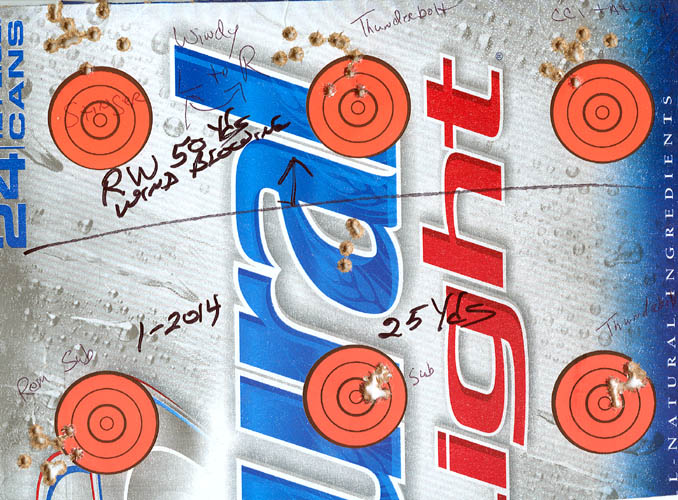
CZ 452 TRAINER SHOOTING RINGS AROUND THE SAVAGE MARK II
One of our friends Don Edwards aka Big Daddy Don purchased a CZ USA model
452 Trainer today and they both fired it off a Lead Sled rest at 48 yards
and the CZ 452 out grouped Robert's Savage Mark II BTV right out of the box
with nothing done to it. We both agreed that Big Daddy Don is one
lucky dude and still has his former boss Rick Jackson in his back pocket.
Don's nickname at work was Teflon Don because nothing would stick to him!
I plan to test fire my Savage BTVLSS on 02-01-14 if the conditions are
right and hopefully will shoot a decent group at 50 yards or at least one
good enough to make consistent head shots on squirrels at that distance.
GROUPS FIRED AFTER PILLAR BLOCKED & BEDDING
NOTE: On 01-31-14, Robert Webster sent me a pix from his
cell phone of a couple 5-shot groups he fired at 48 yards from his Savage Mark II BTV
using CCI Standard Velocity 40 grain ammunition. Looks like the receiver bedding
worked out very well in this rifle. I do believe he will be able to make head shots on
squirrels at 50 yards without a problem with plenty of room to spare.
He said there was a little wind but not too much. There is a big
different between the before and after pillar blocks and receiver bedding
and the group tightened up tremendously. You can cover those groups up
with a dime and I asked Robert why he used a penny instead and he said the
penny photographed better than the dime. Pix below:
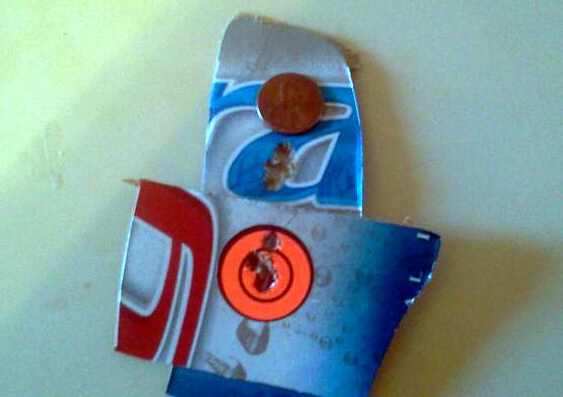
PS I have noticed that on Robert's target backers, he is
using empty Bud Natural Light Beer cardboard cases which seems like a lot of
beer being consumed there. Robert said he got the empty boxes from the
VFW and places a brick in the bottom of them to keep the target backer in
place and put the bullseye stickers on them. I expect I had the same
look on my face when I told the Lady at the ABC store I was purchasing using
some good Bourbon to make home made
Vanilla Extract. That's my story and
I am sticking to it. Grin if you must!. Recycling
is the word of the day!
Well, it looks like the pressure is on yours truly now to see if my
Savage Mark II BTVLSS will hang in there with them after the pillar block
and receiver bedding job. I got the missing
parts in this afternoon for my
Sinclair rest and will shoot a few 5
shot groups tomorrow and see if the pillar block and receiver bedding did
the rifle any good. The jury is still out on this one.
Web published updates on 01-31-14 by Bill aka Mickey Porter
PORTER'S MARK II BTVLSS FIRED AT 50 YARDS
02-01-14
Got a chance to shoot a few rounds through the rifle this morning and not
the best of conditions.........had a little wind and it was below freezing.
Well, the jury finally came in with the verdict for this rifle and I believe
it is a keeper. Below target fired using CCI Standard Velocity
ammunition with a 40 grain solid lead nose bullet:
NOTE: Thumbnail pixs deleted and not recoverable!
The bottom group is around .600 inches outside diameter and had some
wiggle on the bench rest but not bad. I later found that I had not
tightened down on the fine vertical adjustment knob enough. This rifle is definitely capable of
making a head shot on
a squirrel at 50 yards if I do my part of which was my main goal and plan for this rifle.
When the weather conditions are more agreeable, I plan to test fire half a
dozen or more different brands of ammo to ascertain which one the rifle prefers
and hopefully my shooting skills will improve also.
MODIFICATION TO THE ACCU-TRIGGER
One last modification after doing the above test firing was
removing the accu-trigger blade and spring from the
trigger group assembly which made the trigger much more crisp. I checked that the safety was still
working fine and put the safety in the fire position and hit the side of the
stock hard to see if it would jar loose the sear/trigger engagement and it did
not. The best mechanical safety device when a live round is loaded is
to have the bolt
out-of-battery, meaning lift the bolt
upwards and the weapon will not fire even with the safety in the off
position, of course I do utilize the mechanical safety at all times until
ready to fire and keep the weapon's muzzle pointed in a safe
direction at all times!
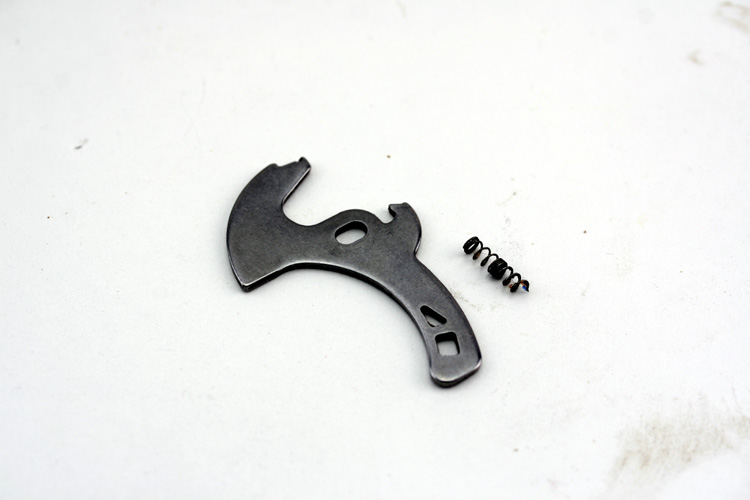
The accu-trigger blade protrudes about 3/16 inch forward of the trigger
and when I touch the "blade" to engage the trigger, I start the trigger squeezing process which
makes for a long trigger pull. If you don't engage the trigger
properly with trigger finger
pad centered between the first joint to the tip of your finger and pull the trigger back
in a straight line motion, there is a good amount of resistance felt by the
side to side friction of the "safety blade" against the slotted trigger that has a slot cut
into it for the blade to travel. Some shooters employ the usage of the
tip of the finger only but it takes more effort and will result in a
straight line rear trigger movement; it works for some and some it doesn't I have never owned a rifle
with this type of trigger and personally don't favor it although it is an
extra safety feature allowing you to adjust the trigger poundage safely down far
below what most manufacturers recommended trigger pull which is pretty heavy
for liability reasons which is understandable.
My early 1980s Remington Model 700 chambered for .270 Winchester
came with a stock Timney adjustable trigger and will safely go down to about 38
ozs. Anything less than that, the sear will release from the
trigger upon closing the bolt very hard which is a very dangerous situation.
When I first began testing out different hand loads to find the best
grouping, I took the trigger adjustment down below 38 ozs. and it was a
shocker when I closed the bolt on a live round and it went Boom!
I checked the trigger pull poundage on the BTVLSS and it averaged out to 1 lb.
7.7 ozs. which is about where I want it for hunting. I am
looking at a
Basix Sav-Rat trigger replacement at the
moment but will keep test firing this rifle before doing anything else to
it. With some practice, I am certain I can make one ragged hole
grouping at 50 yards with this rifle which is now a
KEEPER!
TRIGGER ASSEMBLY HOUSING EXCESSIVE CLEARANCE
Robert Webster was the brain storm on removing the "blade" from the
accu-trigger and I had not noticed as much side to side play but there was a
good .030 to .040 clearance between the trigger assembly housing and the
width of the trigger. Removing the accu-trigger blade portion did not
create this problem but it was more evident with the blade removed from the
trigger. After surveying the scene it was obvious that the trigger
housing was fabricated from flat steel and bent into shape. The base
of the trigger housing is secured to the receiver with two 1/4 x 20 tpi bolt/lugs and the
sides of the trigger assembly housing are held in position with three pins
that have E clips. As already stated, there was at least .030 inches
of "gap" between the width of the trigger and the trigger assembly housing and you
could pinch or squeeze in on the trigger housing and see how much slack or gap
was present.
I used a feeler gauge to ascertain what thickness washer was needed and
placed a .030 thickness washer underneath the E clip that held the trigger
in place within the housing. Click on below thumbnail pixs of the
trigger assembly with the washer in place that removed the trigger side to
side movement:
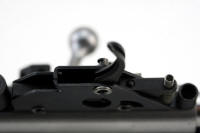
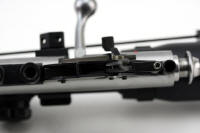
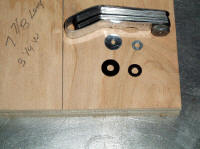
The flat washer worked like a charm and no need to place it inside the
trigger housing which might create additional friction increasing the
trigger pull. There is still a few thousands of an inch clearance
between the trigger and the trigger housing assembly which is necessary to
prevent any increased friction. A couple .015 inch thickness Teflon spaces could be used
inside the trigger assembly housing to reduce any possible trigger/housing friction but don't think it is necessary. I
checked the trigger pull poundage and it dropped down to 1 lb. 4.8 ozs.,
a reduction of 2.9 ozs. with the accu-trigger "blade" removed and the slack
out of the trigger housing. The trigger is very crisp with no
perceivable felt creep or grinding at all.
PUTTING THE PROVERBIAL CART BEFORE THE HORSE
As mentioned earlier on this page, I have an
ATF form 4 pending approval
since August, 2013 to own a suppressor for this rifle and decided to ship the barrel to Accurate Ordnance, LLC
in Winder, GA on 02-07-14 to machine 1/2 x 28 threads on the barrel
and also purchase a custom stainless steel barrel thread protector. This is not the first or
probably the last time that I have put the
proverbial cart before the horse
and guess that is just part of my DNA makeup. Below pix of an overkill
on the shipping box I made from scrap lumber:
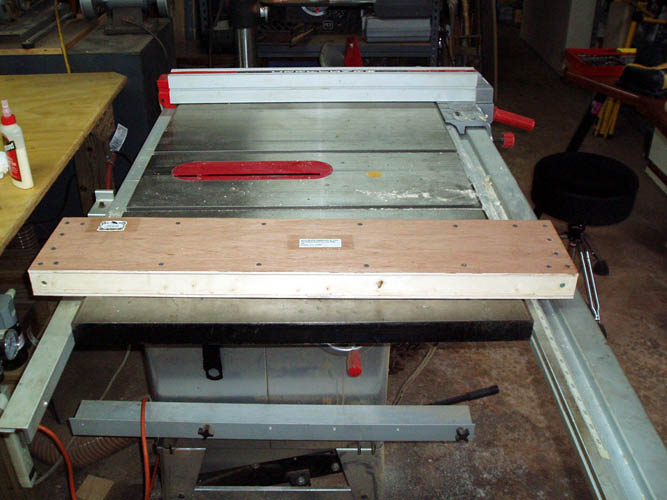
If the USPS damages the barrel/receiver that is also bubble wrapped in
this shipping box, there has to be some humongous rough handling going on.
To be on the safe side, I purchased 300 bucks worth of extra insurance which
should cover the cost of a new barrel/receiver if bent in case you do
not want
to shoot around and from behind a tree or something..........grin if you
must! I have observed how personnel load luggage onto a plane and it is
down right scary to watch them actually throw the luggage and packages and a miracle anything arrives without damage and
I am sure there is no finesse either with other carriers with such tight
production schedules! Updated on 02-08-14
THREADED BARREL AND BARREL THREAD PROTECTOR RECEIVED
02-26-14
I received my receiver/barrel back today from Accurate Ordnance, LLC and
Jason Nixon did a First Class All American job threading the barrel to 1/2 x 28 tpi
and the custom stainless steel knurled thread protector. I put the
trigger group assembly back onto the receiver and the receiver/barrel slipped
right into
the bedded stock like a glove with no problem. I got a chance to fire
a quick 5 shot group of CCI .22 cal short CB rounds at 20 yards before dark without a solid rear rest and
four of the five shots made one ragged hole and the other one was a little
high, whereas the muzzle report was much louder indicating a hot round.
A few pixs taken:
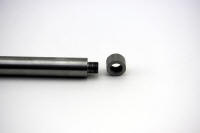
The barrel outside diameter was large enough (.801) that the original crown
remained intact with plenty of room to spare. I like the way Jason
angled/flared (chamfer) the forward portion of the thread protector and extended it out
further from the muzzle crown for additional protection. Now to
continue the long wait for the suppressor which I hope is within a couple
months away.
I highly recommend the services of Accurate Ordnance, LLC in Wintre,
Georgia.
NOTE: The hyperlink to Accurate Ordnance, LLC was removed,
due to the website no longer active or their contact links and/or telephone
number.
Quoted from Marks Facebook page January 2, 2020: "We
want to sincerely thank everyone who has supported and encouraged us the
last few (9+) years. We greatly appreciate you. Unfortunately,
we have decided to close the shop. I am dealing with a parent in
Hospice care and my attention needs to be elsewhere at the moment.
Jason is retaining the CNC lathe and tooling with intentions of setting up a
new shop. We'll make sure the word gets out there when that happens.
We're contacting the few remaining customers with projects to make
arrangements to make sure they are satisfied. So, if you are one of
those customers, please be patient and I promise we'll reach out to you.
We appreciate everyone's understanding and wish you and your families a
happy and blessed New Year.
Mark Kuczka"
Web page updated by Bill aka Mickey Porter on 07-07-2020.
When the weather breaks, I plan to spend several days on the range test
firing different brands of .22 cal. long rifle ammunition to ascertain what this
rifle likes to digest the best. In the lower priced ammo, CCI Standard Velocity
does very well. As I stated earlier, my goal for this rifle was to
have an excellent squirrel gun capable of making clean head shots out to 50
yards and this rifle will easily do that. I don't expect it to perform
like a well tuned multi-thousand dollar competitive benchrest rifle in the
10.5 pound class with 1/4 minute of angle or less accuracy with the fore end
resting on a grand plus front rest, but I do plan to
squeeze all the accuracy from this rifle that I can...............grin if
you must!
RANGE TIME 03-01-14
The weather finally gave way from the cold, rain, sleet and snow for a
while and got a chance to load my gear and head down to Cason's Oldfield and fired some practice rounds. It was still windy with
a cross wind of about 5 to 15 miles per hour and gusting at times but
managed to get some trigger time in nevertheless. Below a few pixs of
my set-up:
Fifty (50) yards does look a far piece but the Weaver T36 scope
brings the 7/8 inch outside diameter bullseye right up into your face for a much better
view!
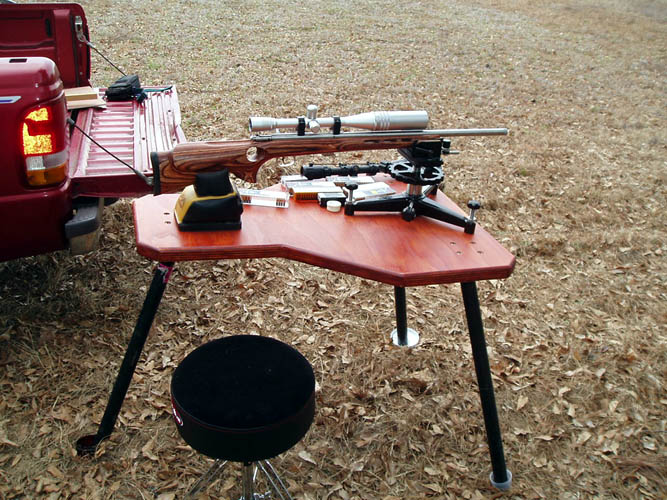
The home made
portable shooting bench is very stable in combination with
the Sinclair front rest and the Protector rear bag. The wind was just
too much to get reliable test results for the different brands of ammunition
but the higher velocity ammunition did a little better than the standard
velocity which might not be the normal. I fired several groups last
month using the CCI Standard Velocity ammo and got decent groups but not so
today..........all brands of ammo except Eley Match grade did horrible and
the Eley was not that great either and hopefully will get out there very
soon when the wind calms down. The month of March is usually one of
our windiest months in this neck of North Carolina with the ole saying, "March
comes
in like a roaring Lion and goes out like a Lamb."
Using a Weaver T36 scope and target distance of 50 yards with the smaller
bulls eye outside
diameter 15/16 inch. I also switched to a Bushnell Banner 6-18X and
shot some of the targets as I was getting a good amount of heat mirage
during the mid day. Click on below target thumbnail scans for a
larger screen view:
There is no question the
Eley Match ammunition is superior to anything I fired
today. "Most of the time, you get what you pay for."
I plan to test fire Standard Plus, Norma USA TAC-22 and Eley Tenex in the near
future.
I got an excellent 5 shot group on 02-01-14 using CCI Standard Velocity
ammo, however the wind was very calm. The Eley Match grade ammunition
definitely did better today and the wind didn't affect it as bad as the
other brands of ammo. I did notice that some of the ammo that I
applied the home made lube consisting of beeswax, Crisco and Ballistol, the
groups were a little tighter. I plan to shoot in the near future when the wind is very
calm and try several other brands of subsonic ammunition for comparison.
Any of the cheaper ammunition tested above would take a squirrel's head
out at 50 yards when zeroed for that brand of ammo and that is my goal.
Many shooters on a budget will sort the cheaper bulk ammunition by rim
thickness and also by weight in hopes of getting rid of the occasional
flyer. Web published update on 03-01-14.
Eley ammunition still groups the best although the windy conditions is
not a true test of the accuracy potential of each brand of ammunition fired
in this rifle.
Hopefully, I will get a good windless day and get more reliable consistent
results.
The Norma USA TAC-22 ammunition grouped fairly well as did the Standard Plus considering the gusting
wind. I fired a couple good groups of Federal Auto Match Grade ammo
when the wind was calm and plan to check the rim thickness of different bulk
brands of ammunition I have on hand as soon as my dial indicator comes in. I already had a rim
thickness tool to help make it a little easier. Also, the home made
beeswax/tallow lube
shows some promise already and plan to add additional beeswax to the home
made lube
since the beeswax/tallow mixture softened up when the temperature got up around 70
degrees. I used about a 1/3 ratio of the beeswax to tallow and will
increase the beeswax to 50 percent and see how it works out.
I was hoping for better accuracy results with the cheaper ammunition but
so far this gun doesn't shoot the bulk ammunition that well. A tack
driver this rifle certainly is not, but a good squirrel gun
out to fifty (50) yards which was my original goal.
HOME MADE BULLET LUBE
It appears that the better grades of target ammunition has a generous
amount of lube (greasy to the touch) and Eley is reported to use a
combination of pure beeswax and
tallow
of which their formula and application process is naturally a trade
secret! I have already tried beeswax and Crisco
shortening and there is some improvement on bullet accuracy but as most have
said, "You can't take a bad bullet and make a good bullet, but you can take
a good bullet and make it better" with lubrication. I purchased five
plus pounds of beef scraps/trimmings to render the tallow which is nothing
but the fat.
Lard is the same thing but it is from Mr.
PIG. I didn't do any sequence pixs since the only thing you do is cut
the meat up into small chunks and place in a large pot on low/medium head
and stir it around every 15 minutes or so until all the grease (tallow) is
rendered which takes about two hours. I strained the cooked meat trimmings
and grease through several layers
of cheese cloth over a colander into another pot after it had cooled a few
minutes. The tallow came out amber color while still liquefied and
when it cooled down it was an ivory color. The tallow will keep
refrigerated for at least a year. Five plus pounds of beef fat
trimmings rendered about a pint of pure tallow which will lube a sizeable
amount of rimfire ammunition. I plan to start out with
a 50/50 mixture of beeswax and tallow and melt it to the smoking point
before dipping the bullet tip into the hot home made bullet lube allowing
the excess to run off. Both products have a fairly low flash point,
therefore extreme caution must be used and not allow the mixture to get too
hot. Pix of the rendered tallow and brick of beeswax:
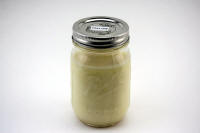

Web published update on 03-04-14
REDNECK STOCK FOREND BENCHREST ADAPTER
With some time on my hands, I decided to make a three (3) inch wide x 7.5
inch length flat stock forend benchrest adapter
mimicking a standard flat benchrest rifle stock, whereas the Savage
thumbhole stock is about 2 inches in width at the sling stud with a radius on the bottom
and the width increases a good 3/16 inch as well. The Savage stock already had two
forward stock studs for a sling swivel and bi-pod and used the two 3/16 inch
diameter holes without having to drill any extra holes into the stock.
My antique worn out
rasps and surform tools got a good workout on this little
project, however I removed the bulk of the material with a 3/4 inch diameter
two fluted flat bottom carbide tipped router bit installed in a 3 1/4 HP
Porter-Cable router mounted to a Bulldog router table. For the most
part, this project was old school with no special jigs or duplicating
devices which would have been great! I varied the depth
of the router cut and staggered each successive cut and
got the convex curvature in the ball park before using the rough toothed rasp and Stanley Surform to blend
the concave curvature/radius. The adapter added about .875 inches
overall thickness increase to the existing stock. I didn't take any
sequence pixs and below a few thumbnails of the project getting its first
coat of
Formby's Tung Oil finish and pixs installed
on the rifle stock:
NOTE: Thumbnail pixs deleted and not recoverable!
I need to find a piece of cushion rubber type gasket material to place between
the stock and this stock forend adapter since I didn't get a perfect one to
one fit between the two parts but it doesn't look too
Reneckish.........grin if you must! I didn't take any
serious amount of extra time with the forend adapter as far as sanding it down to a super
fine finish but
left the 100 grit belt sander grit marks on the forward and rear portion of
the adapter. I did smooth out the flat and side portion a little but
again, still didn't take any serious time with this project. If it works out,
I will find an appropriate cushion material to install between the adapter
and the stock and replace the impromptu cut pieces of felt which is all I could
locate in my shop on quick notice. I removed the sandbag from the
Sinclair benchrest AP windage top and this stock forend benchrest adapter
slides like silk back and forth with no wobble or cant which should increase
my shooting accuracy. However, I placed the sandbag back onto the
windage top and there was enough room for the three (3) inch wide adapter
and flattened the sand out and squeezed the ears of the sandbag in which
made good firm contact with the lower side portion of the forend adapter
keeping it snug and flat. Next on my list will be more range testing to
ascertain how this impromptu Redneck Stock Forend Benchrest Adapter
performs. Web published updates on 03-06-14.
NOTE: I did a Goggle search and found that
Sinclair makes a similar forend adapter for
Sporter rifles being more high tech than my wooden version and there's is
adjustable for different stock widths. Oh, Well; I wouldn't have
had all the fun with the sawdust and wood chips flying around
either......grin if you must!
I removed the redneck home made benchrest forend adapter since I plan to
squirrel hunt without it and the curvature was cut free hand and had trouble
getting a perfect vertical alignment with it since it was skewed to one side
making my scope crosshairs canted as well even though the scope was square
with the rifle. When I have the time and think about a better way to
carve the radius more accurate, I might give it another try.
ROOKIE MISTAKE FOUND ON 03-12-14
After firing the Savage on 03-11-14, I was not too impressed with the
grouping and the next day while removing the scope, I noticed that the rear
scope dovetail base mount was "loose as a goose." It was so loose that
when you moved it back and forth it would actually make a rattling sound.
I checked the front mount and it was only finger tight. This was
probably the first new rifle that I have ever purchased that had the scope
base mounts already installed on them from the factory and you guessed it,
assumed they were tight. I removed the mounts, cleaned the threads on
the rifle receiver, screw threads and applied blue
Locktite Threadlock Blue 242 to them and
applied 15 inch pounds of torque. I would have liked to gone higher in
torque but was afraid that I would strip the threads or break the heads off
the little 4-40 tpi screws.
THE ART OF RIMFIRE ACCURACY BOOK BY BILL CALFEE
While doing much internet research on rimfire rifles and accuracy, I ran
into some old threads that Bill Calfee had responded to a couple years back
and ordered his book,
The Art of Rimfire Accuracy and have really
enjoyed reading about his personal experiences from his youth and also his
writing about what it takes to make an accurate rimfire rifle. I was
totally amazed at what detail goes into creating a winning benchrest rimfire
rifle. Bill Calfee has created many top winning rimfire benchrest rifles
and he definitely thinks outside of the box. The book does go
into some technical treatise on benchrest rifle construction, whereas you definitely
can learn much about what he has done and how he arrived at the conclusions
that he makes which many are controversial to say the least, especially about factory, custom actions and barrels, etc. He
tells it like it is and doesn't try to sugar coat things! Bill does hold
back sharing some proprietary techniques such as creating match chambers and barrel lapping which is certainly understandable
from a business standard......don't give up your hole card! 03-31-14.
RANGE TIME 04-01-14
I planned on getting an early start this morning to head to Casons Oldfield but my bride had to wake me
out of a sound sleep sometime around 7ish or so. It was after 0830 before I got down there.
I was hoping for a mild windless day but there was a fairly good breeze
coming out of the South but not as much as the last two times that I have
fired the rimfire rifle. Since I found that the receiver scope rings
were very loose, I basically started over test firing the rifle again and
cleaned the bore and chamber pretty good which many don't recommend you
doing but I ran a IOSSO blue nylon brush through it with some Hoppe's Nr. 9
and unscrewed the brush at the end of the muzzle and didn't draw it back
into the barrel. Anyway, below the targets fired and the last couple
were fired using a Bushnell Banner 6 x 18 x 50mm scope and the other targets
were fired using the Weaver 36T scope which is fixed at 35 power. I
believe you definitely have the edge with the larger magnification for
target shooting but my shooting is not the best but slowly improving.
I shot a little better by addressing the trigger more aggressively instead
of trying a super slow squeeze because I would run out of breath before
getting that monster to release even though it is less than 1.5 lbs., a far
cry from a real target trigger of 3 ozs. or so......grin if you must.
The best group I got was with the Eley ammunition which is to be expected
even though this rifle is not a true target rifle by any stretch of
the imagination, however I sure would like for it to shoot like one but that
is just not the case. Part of the trouble is my own shooting inability
because I haven't target shot any since the 1980s and that was with a
Remington 541-S and didn't shoot out to 50 yards either, more or less around
30 yards and about any clunker of a rifle with decent ammunition will group
pretty good at that distance! I also removed the home made Redneck
benchrest forend adapter since I am basically starting over again with
ammunition testing and I now have a good idea what shoots the best so far in
this rifle. I will add the benchrest forend adapter back on prior to
my next range testing and see if there is any difference. Below the targets starting with a
sighter target on the left. I am using the new Windows 8 operating
system and all my audio and photo editing software has been a dawg to try
and get to work and most will not work and is not supported by Windows
8....a bummer for sure.
I had to scan the below targets using my older XP Pro system that I just
took off-line and transfer the scans to a flash drive, upload
to this Windows 8 PC desktop and do the image editing using Adobe
PhotoShop CS2. Click on below thumbnails pixs for a larger screen
view:
NOTE: Thumbnail pixs were deleted and not recoverable!
The bulk Federal ammunition shoots the worst out of this gun and the
Norma ammunition and Eley will be my squirrel hunting rounds at the current
time for sure and leaning more towards the Norma USA TAC-22 because it is much
cheaper than the Eley. The CCI Standard Velocity is accurate enough
also to harvest squirrels (head shots) at 50 yards as the Standard Plus ammunition but it
is hard to find in this neck of the woods. Our ammunition
price gougers,
e.g., most retail gun shops and pawn shops that
sell firearms are really taking the shortage of ammunition and milking it
for all it is worth. It reminds me of the businesses selling supplies;
e.g., plywood, ice, generators, bottled water. etc.
before the onset, during and after a hurricane, ice storm, etc., but NC has enacted laws to
deal with the price gougers. Most gun shops and pawn shops are marking their ammunition up 250 to
300 percent of the manufacturer's suggested retail price (MSRP) in
additional to the wholesale price they are paying for it. I would like
to tell them where they need to store their ammunition and an occasional
round
accidentally discharging might get their attention........grin again if you must!
Wal-Mart and a few of the Internet places like Midway USA and Brownells are
still keeping their prices near the MSRP level but they are experiencing the
same supply shortage as everyone else. However, the high dollar stuff like
Eley Tenex is still very plentiful and available but at 19 bucks for a 50 round box
for non benchrest
shooting is very expensive or at least for my shallow pockets and short coat
tail.
I plan to continue to shoot when conditions are conducive
and hopefully my shooting skills will continue to improve. I am also looking forward to test firing this rifle with the suppressor and see what
change that amount of weight on the end of the barrel does for accuracy in
addition to the reduction of the muzzle report. The State of North
Carolina General Assembly passed a law in October of last year, whereby we
can now hunt with silences aka sound suppressors which is great.
I ordered a
Harrell Style Muzzle Tuner in silver color
for this barrel a few minutes ago and hopefully it will help with some of my
vertical/horizontal bullet stringing and definitely cannot hurt anything.
Only trouble, it will have to take a back seat to my suppressor when it
arrives unless the suppressor shoots just as good. 04-02-14.
HARRELL STYLE MUZZLE TUNER RECEIVED 04-07-14
I received the Harrell style muzzle tuner this afternoon from
Killough Shooting Sports and it fit very
snug and tightened the two screws just tight enough to keep it from rotating
on the barrel. Below a few pixs of the tuner:
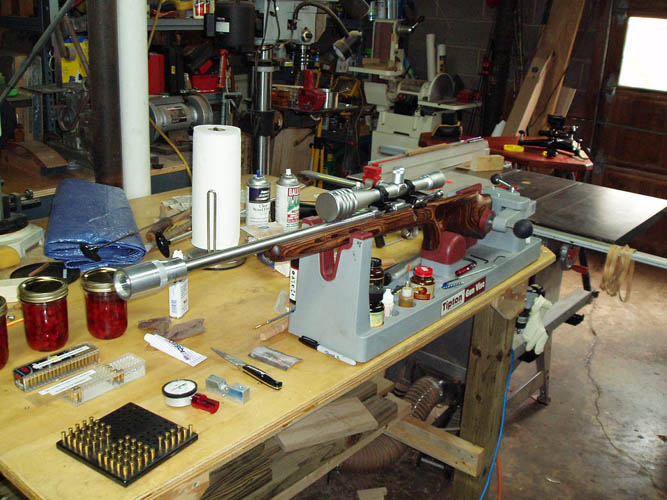
Most of what I have read so far, a muzzle tuner does help and/or stop the
muzzle vibrations which is a good thing according to the many experts out
there shooting them and also the custom gunsmiths. I realize the
barrel tuner is no substitute for a very accurate barrel but I am going to
see if it will help tighten up the groups on this factory Savage Mark II
BTVLSS north of the USA border barrel. If not, I will save it for another barrel down the road
but I believe it will help this barrel since I am beginning to get some
improvements. The weather here in NC for the next few days is rain and
more rain and will try and get to the range and do some shooting and see if
I can dial the tuner in to my barrel. I am hoping the standard tuner
which weights around 8 oz. will not need any extra weights for this .800
diameter barrel which is 21 inches in length because I didn't order any
extra weights not knowing what I would need. This whole project has
been a trail and error thing but being retired I have the time to mess with
it. It would have been much easier to just purchase a high dollar gun
to begin with hoping that the the accuracy I desire would be there and it
definitely is not the same criteria as benchrest shooters requirements by a
long shot. I haven't seen a gun shop close by that will let you test fire a
weapon before purchasing it and basically you are "buying a pig in a
poke" as the ole country boys say out loud! I am looking for a constant cluster/round hole at
50 yards that measures less than .5 inch (outside diameter) and somewhere around .375 inch
(outside diameter) which will be a killer squirrel rifle at that distance. With good
ammunition, the Savage is knocking on the door right now. There aren't
too many factory non-benchrest rifles that will constantly group .375 inch
outside diameter at 50 yards so it might be an impossible goal to attain
without re-inventing the wheel so to speak but I believe this rifle just
might do it. Hey, I just might turn pig iron into the luster of goal
yet.........grin if you must!
RANGE TIME 04-10-14
This morning was one of the better mornings weather condition wise with a
slight breeze coming from the East and probably gusting from 5 to 10 mph and
it would get calm just for a little while. I had a chance to play with
the Harrell style tuner and didn't have any extra weights to add to it but
looks like I might get a set and run it through the gamete since it appeared
to do better at the maximum setting of 500 increments of which I believe the
tuner weights around 8 ozs. I cleaned the rifle barrel out with only a
patch and some Hoppe's Nr. 9 powder and lead solvent and then ran some
patches through the barrel until it was clean and dry. Click on below
thumbnails for a larger screen view:
It took about 10 fowling shots to get the barrel to settle down
after the cleaning. I have been trying a
little different technique for shooting since I plan to squirrel hunt with
this rifle and used a much tighter shoulder hold and thumbhole grip instead
of lightly holding the weapon for more free recoil type shooting. I
really need the range firing practice time to keep the rifle steady on the sand
bags and practice breath control, sight alignment, sight picture and
trigger squeeze and of course follow through to get it all to come together.
For all practical purposes, this Savage Mark II BTVLSS
has met my goal of being accurate
enough to constantly make a clean head shot on squirrels out to 50 yards.
Without the pillar and receiver bedding, etc., this rifle definitely would
not do it straight out of the box. With a one piece high tech shooting
rest, this rifle would no doubt shoot much better and remove some of the
"human shooting error" that I currently possess.
Come fall of the year, there will probably be some bushy tail pixs on
here ready for fried squirrel and gravy and/or squirrel stew.
THINKING OUT LOUD
I am thinking about procuring the parts necessary to have a good custom
benchrest rimfire rifle made and have some ideas about the action, trigger,
barrel and stock components to purchase. I am leaning toward the
Turbo action, Jewell trigger,
Benchmark 2 groove barrel or Lilja and McMillan stock but the options are open and
not chiseled in stone.
Since I shoot left handed even though I am right handed, I don't think it
will be a problem using the right hand bolt with a right port opening with
the stock suitable for left hand usage. I have shot most of my life
using right hand weapons off the left shoulder due to a dominant left eye
and only have two left-handed weapons other than archery equipment.
Then again, that is a lot of money to spend on a "squirrel gun".......grin
if you must! After tweaking this gun a little more, I believe I will
not need a benchrest gun to accurately kill squirrels at 50 yards!
SILENCER AKA SUPPRESSOR ARRIVED
It took ten (10) months to get my
Advanced
Armament Corporation Pilot 2 .22 cal. LR silencer aka suppressor
delivered to my doorstep and a special thank you to Eric and Hank of
NC
Silencer who handled all the paperwork getting my application to the ATF and
ordering the suppressor for me and highly recommend their outstanding
services.
Below is pix of the Pilot 2 which is a good entry level suppressor with
36 DB suppression and it reduces the sound of standard velocity and subsonic ammunition
fired to the sound level of a low velocity .22 cal. short round to my
ears. The length of the suppressor is 5.22" with a weight of 3.75 oz.
and about 1 inch in diameter. As with most things, you get what you pay for and there are many
higher priced suppressors out there for the .22 cal. rimfire featuring more
exotic metals but this one
works just fine for my needs.
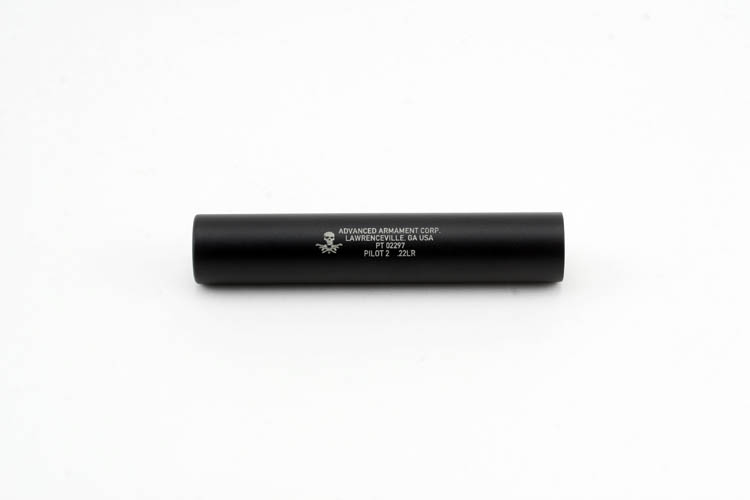
I
removed the Harrell type tuner from the Savage Mark II BTVLSS and
it grouped about the same with the suppressor on there and
acceptable enough for my squirrel hunting needs out to 50 yards. I had to lower the point of
aim on two different scopes I used with the Harrell tuner and got them
pretty close to point of aim but the wind was kicking in and out at around
10 miles per hour (guesstimate) and my shooting form was a little rusty
since I had not fired a round since 04-10-14. I plan to shoot some
early each morning and maybe catch the wind still for a change. I'm
stoked with the performance of the little suppressor and it certainly was
worth the long wait time of which it is currently taking around 12 to 14 months to get
an application processed through AFT due to the increased suppressor demand and not
enough ATF examiners to process all the applications in a timely manner.
Below is target fired at 52 yards with the wind from the West to East and
variable. I used a Weaver T36 scope and had to readjust the elevation
since it was shooting four or five inches high with the Harrell type
tuner removed and below target shot with the AAC Pilot 2 suppressor attached:
The red circle on the PSL target is approximately .565 inches in
diameter and don't think I will have any trouble making clean quick kill
head shots on squirrels out to 52 yards. I later removed the Weaver
T36 target scope and put on my Bushnell Banner 6 x 18 x 50mm and shot it at 18x and the
rifle grouped pretty good even with the lower power. The first ten
shots fired above, I didn't have the rifle butt stock snug against my shoulder and that
accounted for the vertical shots. The last five shots fired on the
above target is what to normally expect with this rifle since I was settling down and
my shooting form was getting much better with each successive shot fired.
Mr. Bushy Tail Squirrel, look out this coming fall hunting season because I
see the makings of a squirrel stew and/or fried squirrel with gravy and
rice!
My goal for this rifle has been met even though it
was an uphill battle of which I enjoyed every step of the way and that is
what counts; getting pleasure and enjoyment out of something you invest your
time and money in. Now to
practice, practice and some more practice; lets make that
perfect practice
instead of just trigger time...........grin if you must!
Web published update on 06-10-14 by Bill aka Mickey Porter.
52 YARD TARGET WITH SUPPRESSOR 06-11-14
Below target fired at 52 yards using the Bushnell Banner scope set
between 12 and 18 power. Robert Webster fired several groups yesterday
on the target before we left the range and the balance fired today by
myself. Note: Robert shot my left hand rifle wrong handed
for him and not bad at all!
The perimeter shots on the target were fired with the scope set at 18x
and you definitely have the edge with more magnification. The Bushnell
Banner Heavy Duplex cross hairs are a little wide for any serious target shooting,
whereas the 1/2 inch diameter red dot is a little small at 50 yards for it.
However, the Bushnell Banner with the 50mm objective lens is much brighter than the
Weaver T36 scope. The Bushnell Banner is a great variable power
hunting scope for a rimfire and so far it is holding its point of aim
without any problem throughout the magnification range but shooting it
mostly at 18X at 50 yards. I have used Leopold 50mm VariXIII on my
deer hunting rifles for decades and pleased with them, however I don't see a
need for the extra bucks on a squirrel rifle.....I am a little too frugal in
some areas but it doesn't hurt to purchase the best if you can afford it.
Web published update on 06-11-14 by Bill aka Mickey Porter.
52 YARD TARGET WITH SUPPRESSOR 06-12-14
Early this morning, I fired 50 rounds of the Norma USA TAC-22 ammo and
experimented with different ways of holding the thumbhole pistol grip.
Prior to this morning, I shot a little better with my thumb out of the
thumbhole more or less straight up lightly touching the side of the stock.
However, since I plan to hunt with this rifle, I need to learn how to use
the thumbhole stock more effectively and tried different amounts of pressure
with the thumb into the thumbhole and it was found that very light to any
pressure worked the best for me. Also, I fully relaxed my grip and
watched the cross hairs on the target to see if they moved. I found
that it was imperative that you have the rifle firmly seated into the rear
and forward sand bags without and movement when you address the trigger and
not try and torque the rifle with your trigger hand to have the cross hairs
dead center on the bullseye. Since the front of the forend is curved
and not flat, it is easy to get the rifle canted even with a good rear bag
in use. There are many variables to get rid of for my shooting skills
to increase to its maximum.
Since I have no experience benchrest shooting other than zeroing the
point of aim for my hunting rifles and checking out various loads to
ascertain the most accurate load for that particular weapon, there certainly
is a lot of finesse and technique to get an accurate rifle to shoot as close
as possible to the point of aim removing as much human error as possible.
My primary goal for this rifle is hunting, therefore I want to adapt
techniques that will work while in the field and not just on a benchrest and
it might be hard to have the best of both worlds but it is fun
experimenting!
I noticed this morning there were several rounds that sounded much weaker
than the others and printed low on the target and a couple sounded louder as
well and went much higher. I realize that the Norma TAC-22 ammo is not
the most accurate ammo but for the money it is doing fairly well.
Web published update on 06-12-14 by Bill aka Mickey Porter.
52 YARD TARGET WITH SUPPRESSOR AND TENEX AMMO 06-13-14
I got a chance to get to the range this morning and the wind was calm but
the humidity was very high. I put the Weaver T36 scope back on the
Savage Mark II BTVLSS and had a box of Tenex on hand that was marked as 1049
feet per second. My first sighter shots were high and having trouble
getting the cross hairs positioned on the bullseye.......the front sand bag
was gripping the forend a little tighter than needed but didn't take the time
to do any adjustments....my bad on this one.
Below is target fired and the ammunition certainly is the key with this
rifle. I still haven't located any Wolf Match Target ammo but the Eley
Tenex will probably be hard to beat.

While not a tack driver at 52 yards, this Savage Mark II BTVLSS is going to be one awesome squirrel gun!
The first pix shows the baffles removed from the suppressor housing of
which the baffles are not in the correct sequence since I moved them from my
table saw where I disassembled the baffles. Using the small tool
supplied with the suppressor, you simply insert two small protruding rods
which will align with the holes that are drilled into the end cap for that
purpose. I had to use a pair of channel lock pliers to get additional
leverage on the end cap tool to loosen the threads. There is an rubber
O ring in the end cap which keeps the baffle assembly tight inside the
suppressor housing or tube and also prevents any gas from escaping between
the threads of the end cap and housing.
I was surprised at how much lead and carbon fouling had already accumulated on the
baffles and tried a quick fix to help loosen the gunk and used some Dawn
dishwashing liquid and very hot water, placed all the parts inside a plastic
container and shook them around in hopes it would help free the gunk buildup
from the baffles of which it didn't do too good a job at all......should
have let it soak an hour or two but too impatient I guess.
I poured the parts into a strainer in our basement sink and rinsed them
off with hot water. Hoppe's # 9 was used with a nylon bristle
toothbrush along with Q Tips and did some serious scrubbing to get the gunk lead
fowling buildup removed. There was a lead slurry formed on one end of
the baffles after scrubbing them and it took about an hour to clean and dry
all the components with the baffles taking up most of the time.
After removing all the lead particles, carbon buildup aka gunk from the
baffles and suppressor housing, I applied a light coat of
Miltec-1
oil to all components to help prevent a carbon build up in the future.
The first baffle in the suppressor that is next to the muzzle is made
from Stainless Steel and has a trademarked coating called SCARmor, whereas the
balance of the baffles are aluminum with a couple tabs that align with slots
in the adjacent baffles to keep them properly aligned and T3 Hard Coat
applied. I
placed a center punch 17/64 inch in diameter inside the
baffles to help keep them aligned while I slid the suppressor housing over
the top of them. I then removed the center punch and placed the end
cap back onto the suppressor housing which I had earlier coated the exterior threads
with Lithium grease to keep the threads from seizing up and/or to let gas
escape by them.
It took the better part of an hour to get the suppressor clean and that
is the price you have to pay for having so much fun shooting with the
suppressor. I talked with a rep. from AAC and he recommended the
product
Kroil to
clean the suppressor of which I plan to try it on the next cleaning.
The application of Miltec-1 should make the next cleaning much easier or I
hope so anyway.....grin if you must!
Web published update on 06-16-14 by Bill aka Mickey Porter.
52 YARD TARGET WITH SUPPRESSOR, CCI STANDARD VELOCITY, NORMA AMMO
AND 4 OZ. WEIGHT 07-15-14
The Savage shoots decent groups with Eley Tenex ammunition at around 1049
feet per second with the suppressor installed and tried some of the cheaper
ammo which did not group as well. I recently added a temporary 4 oz. Harrell style tuner weight near the end of
the suppressor to see if that would help any with the cheaper ammunition and stoked that it did work.
I plan to add a barrel bushing behind the suppressor and it will be large
enough outside diameter to allow an extension tube screwed on the
outside bushing diameter and have clearance between the suppressor to allow
additional weights to be added to the barrel without putting any stress
directly on
the suppressor itself. Below is pix of the
temporary jury rig until I
get the bushing bored and threaded to fit the extension tube and threaded to
fit standard Harrell tuner weights:
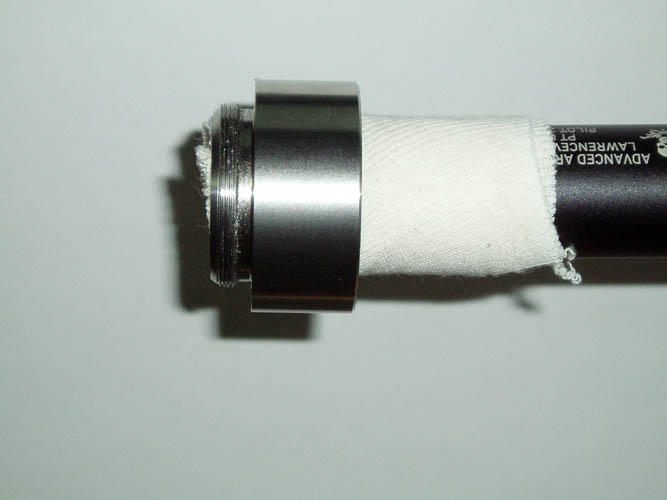
Target fired below with variable winds at times and using Norma TAC-22
and CCI Standard Velocity ammunition:

I ordered a piece of T6 aluminum tubing for the home made tuner
adaptation and I already know that 4 ounces of weight will have me in the
ball park and will have to experiment with the length of the tube to find
the sweet spot since it will not possess the micro tune capability of the
Harrell type tuner but a bloop tube configuration would be more
precise........there is no way to use a Harrell type tuner with the
suppressor due to the inside diameter of the tuner too small and will
experiment with different options.
PORTER CUSTOM BARREL TUNER INSTALLED 10-21-14
I had
Helms Machine Company of Monroe, NC do the lathe work on the barrel
bushing and the sleeve for usage as a barrel tuner. I had them turn
matching threads for the Harrell style
tuner weights and they did a great
job. Steve did a first class All American job and was to my specifications. Pix below:
With this novel and unique barrel tuner, it allows you to tune your
barrel while using the removable AAC Pilot 2 model suppressor. I
installed additional weights on the end of the internally threaded sleeve
but after testing, it was found that I did not need any additional weight on
the end of the sleeve. I could fine tune the tuner by moving the
barrel bushing and threaded sleeve in small increments toward the receiver
but it is shooting decent groups as is. When I retrieve the 52 yard
targets fired, I will take a few pixs of it and post the groups fired
showing the difference between no barrel tuner, just the suppressor and also
the tuner with weights and without. Another pix from the muzzle end:
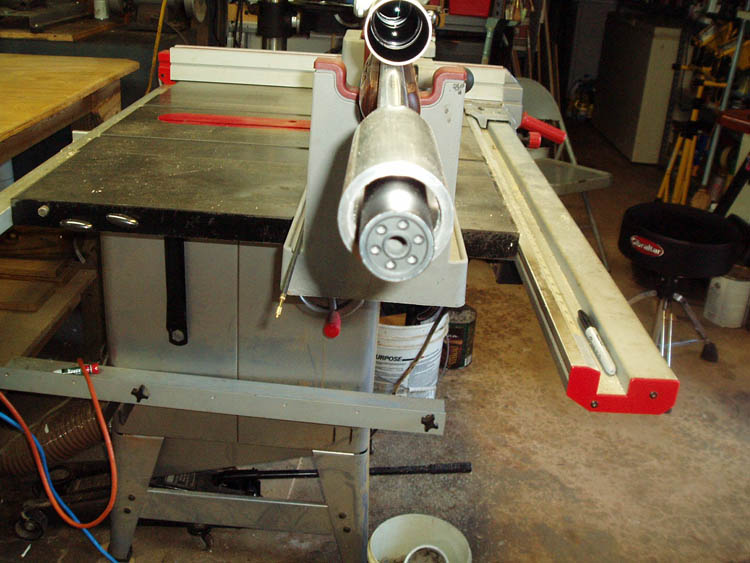
NOTE: I moved the barrel tuner
and bushing about 1/4 inch toward the receiver and noticed that accuracy
increased. With the barrel tuner bushing not making contact with the
treaded end of the suppressor at the
barrel muzzle, the muzzle report was much quieter and did not
hear the pronounced metallic ringing sound that was not there before I
installed the barrel tuner. Apparently moving the barrel bushing and
tuner away from the muzzle end finding a much better "sweet spot" stopped
the barrel vibration as evidenced by the lack of the metallic ringing sound,
although I am sure this is debatable since I have no scientific evidence to
validate my claim, other than a 5 round bullet cluster. When I shot
this rifle with the Harrell style tuner before having the barrel threaded
and using the suppressor, I did notice a pronounced ringing sound produced
by the Harrell style barrel tuner. I will fire additional groups and
get a more accurate picture of what is taking place. So far, the
Porter Custom Barrel Tuner over the suppressor is working as expected! I
believe the weight combination of the suppressor and the barrel tuner is
working out pretty good!
Below targets fired with the auxiliary barrel tuner and the suppressor.
The target was used over the course of a week firing a few rounds early in
the morning and the wind was variable to heavy at times and did manage a
couple good groups when the wind was still. I can't remember what ammo
I used or the configuration of the barrel tuner; e.g., with sleeve, with
weights, etc., senior citizen mode kicked in on this one but plan to fire
some next week and make written notes of what I did on each individual
target.

I believe target 14 was fired without the barrel tuner sleeve, only had
the barrel tuner bushing behind the suppressor. Web published update
by Bill aka Mickey Porter on 11-30-14.
Pix below of some empty casings...wonder how many is in that coffee can?
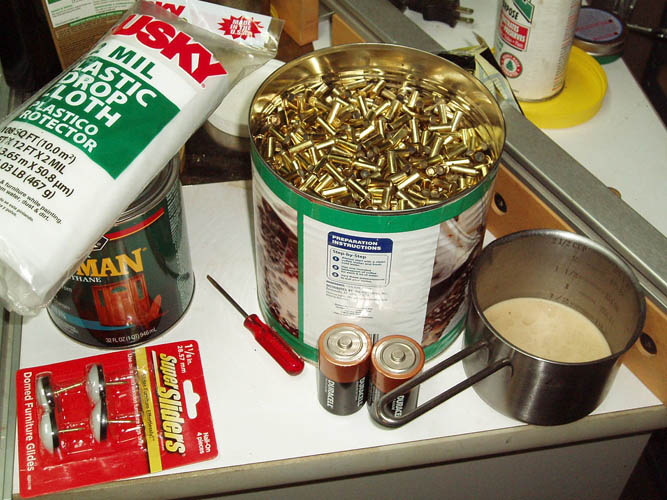
SUPPRESSOR CLEANING 12-24-14
Below are a few pixs of the suppressor after 625 rounds were fired
through it. I used several different brands of ammo including Wolf
Match Target, CCI Standard Velocity, Eley Tenex, Standard Plus and Norma
TAC22:
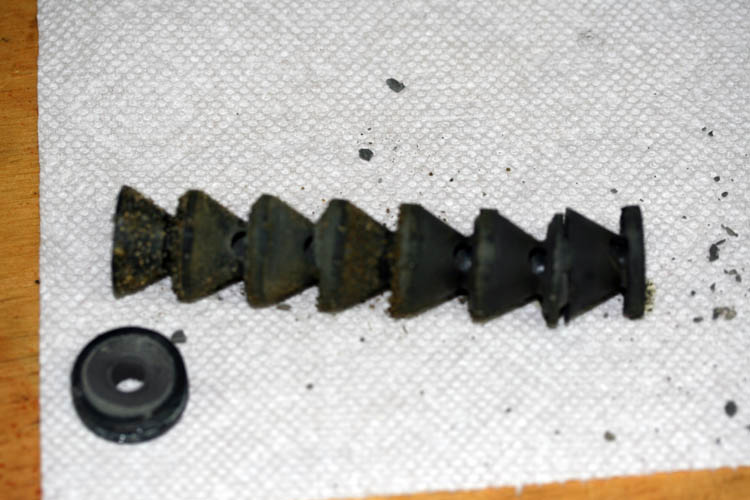
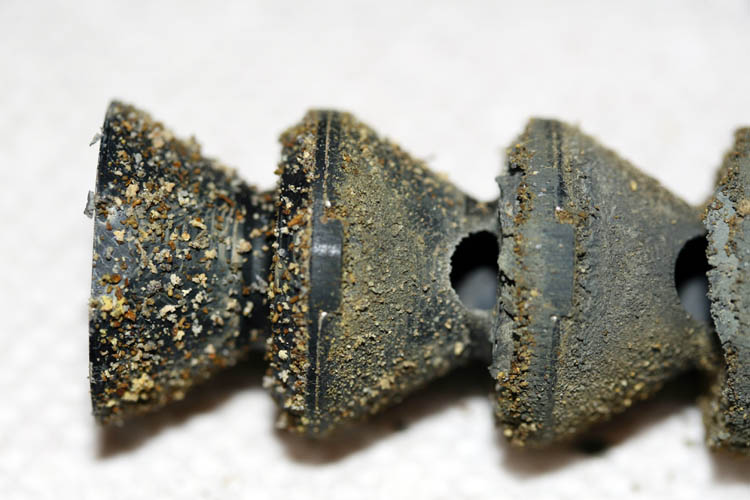
I applied a coat of White Lithium grease after cleaning the suppressor
the last time to see if that would help reduce the cleaning time and I do
believe that it did. I soaked the baffles in Hoppe's No. 9 Gun Bore
Cleaner about 10 minutes and used a small screw driver to dislodge the caked
up lead residue from the small end of the baffles without any effort.
The lead particles did not adhere to the baffles like it did before using
the white lithium grease. I believe the white lithium grease was the
reason the lead particles didn't adhere to the baffles, although the lead
particles still formed a coating over the white lithium grease. It
took about 26 minutes to fully clean the
baffles and have them like factory new again.
I have tried Ballistol, Kroil oil, Hoppe's No. 9 powder solvent, mixture
of auto transmission fluid and Acetone and none of them worked that well and
it took about 3 to 4 hours using the Kroil oil to fully clean the suppressor
baffles which consisted of some serious scrubbing with a bristle brush.
I am convinced that coating the baffles with the white lithium grease is the
answer to quick cleaning the baffles although I believe it catches more of
the lead particles initially. Pix below of the lead build-up removed
from the suppressor after the Hoppe's cleaner was drained off:
As evidence from the pix, you can see the lead particles came off the
baffles in layers and/or chunks. I am very impressed how easy it was
to clean the suppressor this time!
Web published update by Bill aka Mickey Porter on 12-25-14.
FIRING PIN MODIFICATION 05-08-15
It has been several months since "tinkering" with the Savage Mark II
BTVLSS and the ole cliché, "If it ain't broke,
don't fix it" which carries a lot of intelligential weight
was totally ignored today. I had some spare time on my hands this
afternoon and decided to check the firing pin out. The firing pin
along with the extractor and cartridge guide are easy to remove from the bolt by simply removing tension on
the spring steel extractor spring clip that holds them in place by inserting a very
small flat head screw driver under each end of which it can be removed from
the bolt. The firing pin will fall out from the slot or channel milled
into the bolt by inverting the bolt and gravity will do its thing but the
extractor and cartridge guide have a tighter fitting slot that secures them and can easily be
pushed out with a small flat head screwdriver.
I noticed the firing pin has some wear marks on the left side indicating
drag or friction within the slot aka channel in the bolt toward the most forward portion
of the firing pin; about 1/8 inch and decided to slick up the channel a little
on that side using 600 grit wet or dry sandpaper. The channel for the
firing pin was .082 inches in width and the firing pin is .071 inches and plenty of
"slop" aka clearance. I also used a thin wedge shaped hard
Arkansas white stone and stoned a good portion of the slot on both
sides but unable to go the full depth due to the taper and thickness of the
Arkansas stone. Using my 2.5 x MagEyes, I could clearly see tool marks
on both sides of the channel for the firing pin with most of tool marks on
the left hand side. I placed the firing pin in the channel in the bolt
and applied pressure from the opposite side of the firing pin against a small piece
of the 600 grit wet/dry paper to burnish the channel that created the marks on
the firing pin.
I also decided to grind down the area between the shoulder of the firing pin that makes contact
with the barrel when dry fired and take material away from the actual part
of the firing pin that contacts the rimfire shell casing since some expert Gunsmiths like Bill Calfee and others seem to think that it does inhibit accuracy
by not producing consistent primer ignition. To quote Mr. Bill Calfee,
"We want the pin to strike just inside the
outside edge of the rim. We do not want the pin to strike the edge of
the rim where it rolls over itself. That would mean the firing pin is
striking solid brass and combined with the rim hitting the steel breech face
of our barrel causes excessive vibrations, let alone poor ignition." Whether it will help this hunk of metal or not, remains to be
seen....grin if you must. I was a little anxious since this
modification could render the firing pin inoperable in very short order with
too much material removed at the wrong place on the firing pin.
I used my late 1960s model Dremel Tool, still on its last leg and a thin wafer
friction cut off wheel
which is around .042 inches in thickness and secured the Dremel Tool in my
vise and ground the end of the firing pin freehand using the vise as a tool
rest and with the aid of the 2.5
X magnification MagEyes. I carefully ground a little until I though I had what I
needed removed and then assembled the firing pin and extractors into the bolt and
fired a test round. I believe I did this at least four (4) different
times until I got the desired results; e.g., the firing pin striking inside
the outside rim of the shell casing and without misfires of course. I used the
hard Arkansas white stone to burnish/polish the areas of the firing pin that I
ground and made certain there was a very small bevel to the edges of the
firing pin that indents the brass rimfire case, of which the manufacturer
had it slightly beveled already so the entire width of the firing pin would not
strike the brass case. Click on below
thumbnail pixs for a larger screen view:
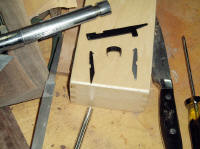
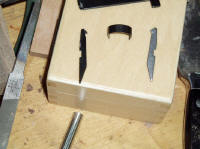
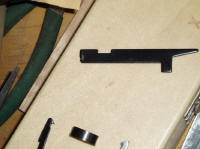
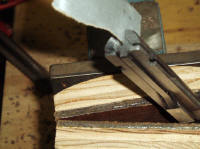
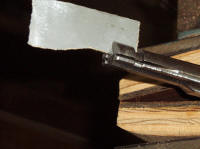

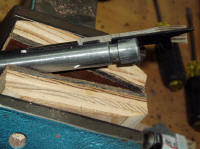
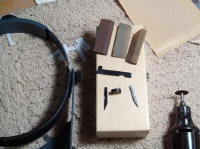
Below are some thumbnail pixs taken with my Macro lens and you can better
see what I did:
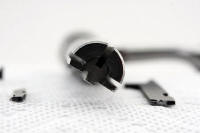
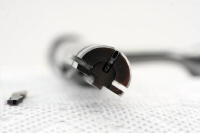
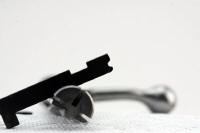

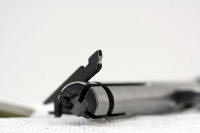
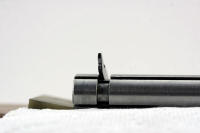
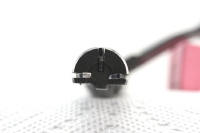
Below is a pix of the fired shell casings showing the progress from left
to right and you can see the shell casing on the right doesn't have the
outside edge of the rim peened, indented or flattened against the barrel rim:
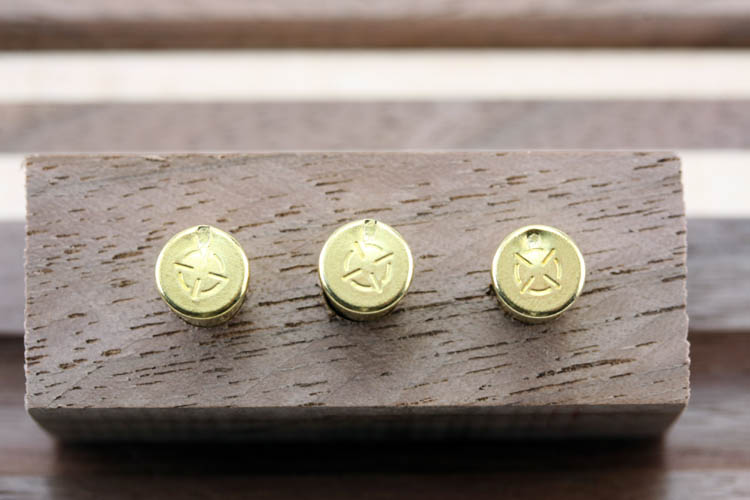
I got the Brown and Sharp dial micrometer out and checked the rimfire
casings. I test fired using Standard Plus 40 grain subsonic LR ammo and an unfired
rim diameter is .271 inches. The fired case diameter across the
rim where the firing pin indents the outside diameter of the rim before the
firing pin was modified was .276 inches. After the firing pin
modification the rim diameter was .2715 inches, an increase of only .0005 inches or 1/2 of a
thousands of an inch. The pix below from the internet and is
located on page 221 in Bill Calfee's book
The Art of Rimfire Accuracy
of which I own a copy:

Below is a Macro close-up pix of a cut-away of the
fired shell casings before and after the
modification:
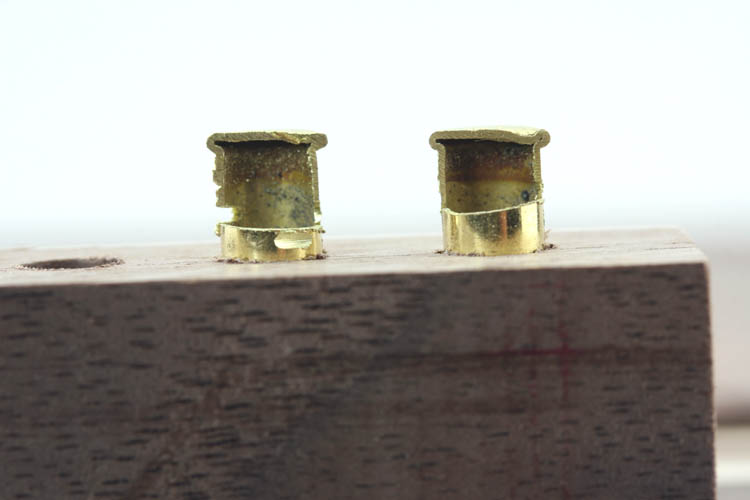
In the above pix, you can clearly see the difference between the firing
pin hitting the rim of the case (left) versus the firing pin hitting inside
the outer edge of the rim (right) and also from the pix on the right, there
appears to be a hotter ignition by the coloration difference between the two
cases also.
With the bolt disassembled, I stoned the face of the bolt but didn't try
and remove all the tool marks/imperfections but leveled it out pretty good.
I was afraid I might reduce the headspace which could cause some problems
with various brands of ammunition. Using the hard Arkansas fine white stone, you definitely don't remove much
material at all but are more or less polishing and burnishing the metal.
I will remount the factory scope blocks on the receiver and dig out the
Weaver T36 scope and if the wind allows, will shoot a few test rounds
tomorrow and see if this helped the grouping any.
I decided to put a one piece EGW Picatinny scope rail on the receiver
after an email from Chris Johnson who is into gunsmithing and has a Savage
he is tricking out. The current Savage Mark II BTVLSS has the new
receiver which has a 1 5/8 inch port opening instead of the older 1 3/8 inch
port opening, therefore I had to order
Product ID 41610 that fits the Savage model
93 which also fits the new Mark II with the 1 5/8 inch port opening.
I mounted the Weaver T36 scope and fired 5 test rounds using the Wolf
Match ammo, however the wind was pretty bad at around 0900. I still
had a Killough Shooting Sports Professional League red bullseye target on
the back stop at 52 yards and the first shot fired went into one of the
targets above the one I was shooting at; couldn't tell which one. I
dropped down a couple target rows and fired another round and it printed two
targets over and one row up. The wind was blowing pretty hard and I
got three (3) rounds with the holes touching. As to why the rifle was
shooting that far off from POA, I don't know since the Weaver T36 scope
holds its settings pretty good. When the one piece Picatinny rail
arrives, I will mount and/or bed it to the receiver and do additional test
firing. If the wind dies down some, I will recalibrate the scope and
fire additional rounds to ascertain if the firing pin modification helped
the grouping.
Web published updates by Bill aka Mickey Porter on 05-08-15, 05-09-15 and
05-10-15.
BEDDING PICATINNY RAIL 05-09-15
I received the EGW Picatinny scope rail this afternoon and bolted the
two rear screws to the receiver and there was at least .003 inches clearance
between the rail forward contact area with the receiver. I couldn't
immediately locate my feeler gage set and used a piece of newspaper .003
inches in thickness to
ascertain the front area that makes contact with the receiver needed
bedding, otherwise there would be torque on the rail (bending) when all four screws
were tightened which is not desirable and this would transfer to the scope
for sure. If the receiver is perfectly flat along with the rail, there
would not be a need to do any bedding unless you just wanted to do so. A stress free relationship between the parts where
applicable is
the ultimate goal. I basically used the same materials left over from
bedding the receiver which was Devcon 10110, plumbers putty, Acetone and
Kiwi neutral wax shoe polish. I didn't want the Devcon plastic steel
putty to adhere to the receiver and coated it a couple times with the wax
shoe polish and filled the two screw holes with plumbers putty. I
cleaned the forward part of the rail with Acetone and plugged the screw
holes with plumbers putty. I then mixed up a small amount of the
Devcon plastic steel putty at a 2.5:1 ratio of resin to hardener and applied
it to the forward portion of the Picatinny rail. The rail was
carefully positioned on the receiver and tightened the two rear screws until the Devcon
plastic steel putty was squeezed out between the receiver and the rail.
You do not install the forward screws, otherwise you would be bending the
Picatinny rail and wasting your time and energy with the bedding. What excess
Devcon putty oozed out between the rail and the receiver was removed with Q-Tips. Click on thumbnail pixs
below for a larger screen view:
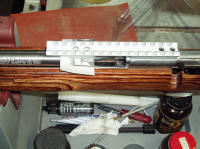
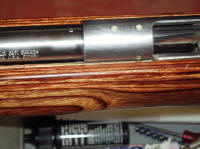
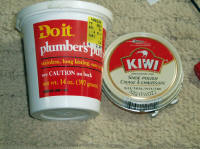
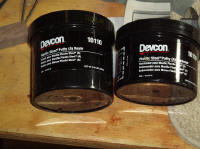
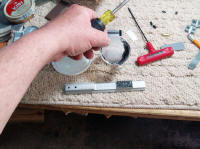

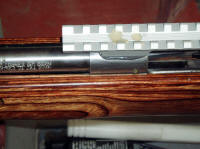
Will let the bedding cure out until tomorrow afternoon and hopefully can
remove the Picatinny rail, clean the putty from the receiver scope base
mounting screw holes and the rail and attach the rail to the receiver using
blue
Locktite Threadlock Blue 242 and torque to
the recommended 20 inch pounds.
I got the rail installed and fired some test rounds but the wind was
horrible and the jury is still out whether the firing pin and/or Picatinny
rail improved the performance of the rifle. I double checked the
receiver and it was found that the receiver is perfectly flat, however the
Picatinny rail was the problem and there was a .003 inch gap under the front
contact area and not the receiver. Also, the mounting screws were too
long for both the front and rear holes in the receiver. There is only
a little over 4 full threads tapped into the forward receiver and had to
grind down the screws using the Dremel tool with the abrasive cut-off wheel
and had to take a couple threads off the other two screws for the rear since
they protruded through the receiver which is only around .125 inches thick.
Click on below thumbnail pixs for a larger screen view:


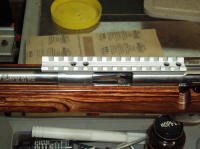
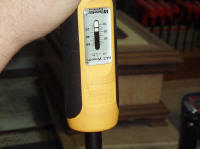
SINGLE SHOT ADAPTER AVAILABILITY
There has been much interest in a single shot adapter for the Savage Mark
II and
Lowey Products in Australia has them molded
out of plastic for 20 bucks each and 6 dollars shipping. I have a
couple on order and will give them a test run in the very near future.
Below is a pix of them:
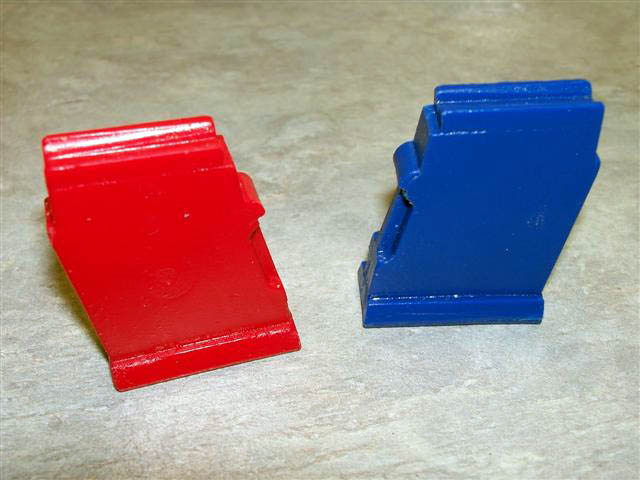
Click on the picture above for a hyperlink to their website with
additional information. 05-10-15.
NOTE: I received the single shot adapters on the 18th and
they work excellent!
TESTING OUT THE FIRING PIN MODIFICATION 52 YARDS
The wind has been gusty the past few days due a tropical depression
moving by our NC coastline and my shooting results hasn't been that good.
This morning the wind was decent and fired some Wolf Match Target and Eley
Tenex published at 1049 feet per second, however they print much higher
and sound much louder than the Wolf Match Target published at 1050 FPS.
I tried different settings on the custom tuner and finally left the custom
tuner barrel off with the tuner barrel bushing nearly touching the suppressor and got my
best grouping. I fired some SK Standard Plus and CCI Standard
Velocity yesterday but the results was very bad due to the wind gusting and
I haven't learned how to read the wind yet either......a rookie for sure!
Below is pix of the last two five shot groups fired:
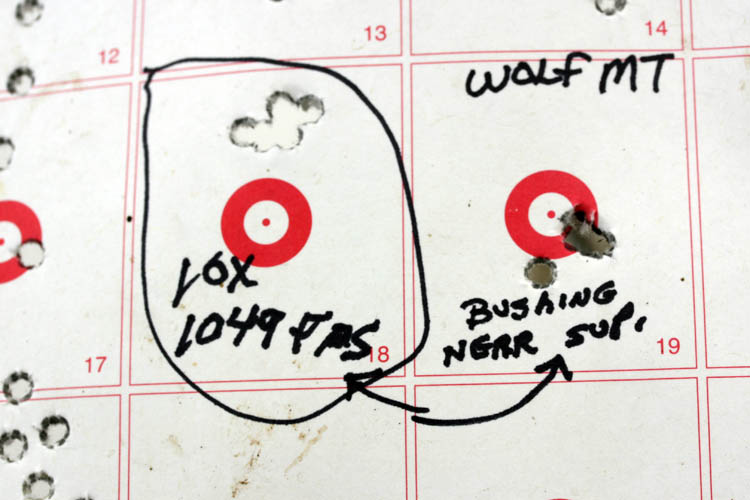
The scope point of aim wasn't moved and you can clearly see the Eley
Tenex printed much higher and also the muzzle report was louder as well. The Wolf Match Target ammo shoots excellent
even with the flier from the main group on target # 19. When the
weather is more conducive to shoot again, I will shoot additional targets to
ascertain if the firing pin modification actually helped any. So far, I
can't really say; "The jury is still out".......grin if you must!
The above two groups are about typical of what this gun does at its best the way it is
set up with good ammo, shooting conditions and shooting form. I really
shouldn't complain too much because the gun has met my goal of head shooting
squirrels at 50 yards but it has taken a lot of time, effort and funds to get to this
point in time. 05-11-15.
NOTE: I fired some of the Eley 10X rounds on 12-17-15 and
set-up the chronograph and the bullets are rated at 1049 feet per second on
the Eley box but they were shooting high and very loud like my suppressor
wasn't working. The five rounds velocity were:
1123, 1119, 1121,
1111 and 1110. I don't know what equipment Eley is using but those
bullets are definitely hotter as depicted by the results above. The
group was excellent though.
FIRING PIN MODIFICATION UPDATE 05-17-15
Remember I started this firing pin modification out on 05-08-15 with a
quote of the ole common sense cliché, "If it ain't broke,
don't fix it", well, I just
couldn't leave well enough alone and went back and took a little more off
and stoned the surface to clean it up. From that point on, I would get
a misfire or two with each 50 round box of ammo fired; this is a guess of
course since I didn't keep a good tally of how many rounds I fired.
The Savage firing pin is a restricted item and only a licensed gunsmith or
firearms manufacturer can order it on line from savage. Man, the rifle
was even shooting the cheaper CCI Standard Velocity rounds with some
accuracy and was about to get stoked at last!
I did an internet search of the closest gunsmith
and also called our local gun dealer who recommend Claude Floyd of Norwood
which actually located on Rocky River Springs Road there in Aquadale and
gave him a call yesterday, whereby setting up an appointment for this
afternoon. I took the rifle and some fired cases and Claude was in
front of his shop when I arrived and we introduced ourselves and he gave me
a tour of his place. To make a long story short, he looked at the
firing pin and recommended that we replace it with a factory one and I left
the rifle with him. If Claude will permit, I would like to do a short
story on him because he does some fantastic stock and forend building and
hot bluing of firearms which appears to be his main expertise among other
things.
I will post additional information when Claude
replaces the firing pin and I will take the ole camera along too.
NOTE: It appeared it would take a week
or two to receive the firing pin from Savage and my friend Robert Webster
invited me to a rifle shoot in Hamlet, NC and I called Claude and picked the
gun up today on 05-20-15 and advised him to give me a call when the part
arrives. It is only a thirty minute drive to his shop and don't mind
the extra trip which has some good back country scenic views to take in
along the way, of which is an extra bonus. In the mean time, I plan to
weigh out a box of CCI Standard Velocity ammo and separate them in groups by
one tenth of a grain. I will then fire a five shot group
through the Shooting Chrony F-1 and see what the velocity of each round
checks out to be and also how the different weight grain five (5) shot aggregate groups.
UPDATE: I have not heard anything back
from Claude Floyd about the firing pin he was supposed to order and since I
got one direct from Savage within a few days after signing a disclaimer of
liability form and with a little tweaking and file work on the firing pin,
it is performing great as of 12-03-15.
I fired a five shot group using the CCI rated
velocity @ 1070 fps but the chronograph went from 1044 to 1083 fps which is
a variance of 39 fps which isn't that great. I tested a five shot
group using Eley Tenex listed at 1049 fps and they were 1088 to 1100 fps
with a variance of only 12 fps. I knew the Eley Tenex sounded much
louder than other subsonic rounds that I have fired and guess the Shooting
Chrony put that question to rest. My Hornady electronic grain scale is
being delivered this afternoon and will weight out some rounds this evening
for tomorrows testing. I know this is a lot of extra things to do but
being retired gives me some extra time to do more of the fun
things......grin if you must! Besides, I have been working out each
morning before the sun is blazing down opening up a drainage ditch using a
shovel and wheel barrow and need a little break! 05-20-15.
REPLACEMENT FIRING PIN UPDATE
A sales rep. from Savage emailed me and said they
would ship me a firing pin for the Savage. I had to complete their
"Release of Liability"
form and email it back to them of which I did. The sales rep. was very
knowledgeable and courteous. They will ship the part at no charge
which is a plus. 05-21-15.
I took another look at the firing pin and decided
to increase the forward travel several thousands of an inch more and fired a
hundred or more rounds through it and without a single misfire. Below
is a close-up pix of a rimfire case cut-away where you can see the indentation
strike of the firing pin and how the modification keeps the firing pin from
striving/flattening the outer most part rim of the case, yet closes the area
where the priming compound is contained causing ignition to take place:
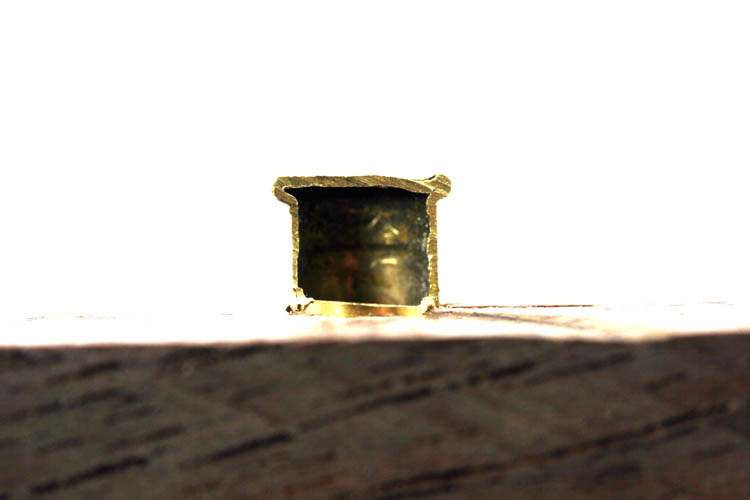
Old school thinking was you had to flatten the outer edge of the rimfire
case for proper ignition but that certainly isn't the
case. As Bill Calfee and other expert rimfire gunsmiths have proven,
the firing pin striking just inside the outer edge of the rim is a better system
reducing vibrations created by the firing pin striking the outside of the
rim against the face of the breech bolt. Those gunsmiths have the
winning race gun records to validate their theory. 05-23-15.
NOTE: I received the firing pin today
and that was some fast service by Savage! The last firing pin
modification (tweak) has the rifle firing each time and I have a spare
firing pin at the moment. 05-26-15.
AMMO TESTING 52 YARDS 05-21-15
Today wasn't the best of weather conditions for
shooting the little rimfire but since I had already weighed out a box of CCI
Standard Velocity and Wolf Match Target, impatience got the best of me I
suppose.
I was hoping that I could find a correlation
between the bullet weight in grains and velocity along with bullet impact
(Point of Impact) on the target but the jury is still out on that one.
I was hoping the weight of the bullet might detect a potential flyer but so
far, that hasn't been the case. There are many, many variables as to
why a flyer round can happen, other than the shooter.
Below a few pixs taken of the target and work
sheets:
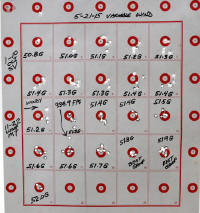

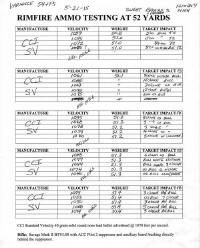
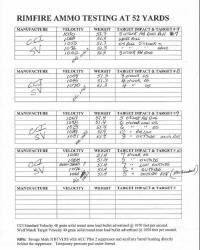
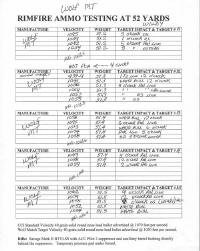
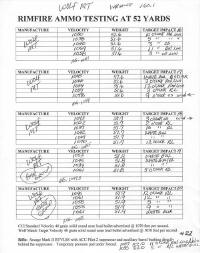
I was really shocked at target # 12 of which the Wolf bullets in this
test group weighted @ 51.3 grains and one round was recorded at 934.9 feet
per second with the other five @ 1045, 1056, 1054, 1052 and 1055 feet per
second. The round was certainly very weak to the ears as well and
printed 1.25 inches below the center of the bullseye. I know this is
only one such test group but the weight of each round apparently didn't have
a direct relationship to the velocity, however the velocity did have a
direct relationship to the POI (Point of Impact) on the target which is
understandable.
The Wolf heavier grain bullets, 51.8, 51.9 and 52.0 did seem to hold a
tighter group than their lighter counterparts but not by a large margin.
Today's weather conditions was not the greatest but I don't think that had
anything to do with the velocity variations; certainly the POI on some rounds fired.
I think the best thing is to find ammo that shoots well in your rifle and
don't be too concerned about why it shoots that way better than the others
but that is "just the nature of the beast" to want answers to the
unknowns.....grin if you must!
As far as hunting accuracy goes; all of the above groups except maybe the
very low POI round would take a squirrels head out without much trouble if
the shooter did his or her part.
TESTING OUT HOLLOW POINTS FOR SQUIRREL HUNTING
This 2015 hunting season, I have harvested a good many squirrels that
were consuming the shelled corn broadcast for the deer around 50 yards plus
or minus from my shooting position. The best of the moderate price
range ammunition has been the Wolf Match Target ammunition in my gun,
however sometimes even with a head/neck shot the squirrel doesn't know it is
supposed to be dead and a few have gotten away before I could get to them.
I knew that hollow point ammunition is the key to do some serious damage to
a squirrels head and that is where the scope cross hairs are settled.
My friend Robert Webster of Hamlet, NC gave me a box of Winchester 40
grain hollow point subsonic and a box of 42 grain Winchester subsonic hollow
point ammunition to try. The 40 grain shot the best but it still
left a lot to be desired in my gun, although it shot excellent in his
rifle. I harvested 5 or 6 squirrels in a row with the 40 grain
Winchester subsonic HP round and it did some horrendous damage to the head
and the squirrels definitely stayed down for the ten count.

I received some Eley 40 grain hollow point subsonic rounds from
MidwayUSA
and they grouped much better than the Winchester 40 grain HP subsonic
rounds. I checked the bullets out with my micrometer and there was a
good bit of difference between the lead bullet band diameter on both rounds.
The Winchester bullet band diameter was only .219 thousands and the bullet
band diameter on the Eley was .224 thousands of an inch and that is a .005
difference. Apparently, my gun likes the larger bullet band diameter
as the Wolf Match Target ammunition in 40 grain solid nose is also .224
inches in diameter. I checked CCI Standard Velocity and the
bullet band was .223 inches and the brass casing diameter was also .223
inches in diameter. I did not set the chronograph up to check the
velocity as it was very windy and not the best of conditions to be testing
out .22 caliber rounds fired but tried and catch the wind at a lull. I
didn't hear any rounds that seemed low and/or high velocity compared to the
rest of the rounds fired. With the rifle being suppressed, it is easy
to ascertain a weak or hot round fired by the muzzle report only and of
course the bullet placement on the target. Below is the target fired over
a few days period:

I have harvested 5 or 6 squirrels (head shots
only) with the Winchester 40 grain hollow point subsonic
round at 48 to 50 yards but this is very marginal ammo for squirrel hunting
and plan to retire that ammo for punching paper only
since the Eley 40 grain hollow point subsonic is far superior grouping in my
hunk of junk metal called a Savage Mark II BTVLSS.
I ordered a .22 caliber resizing die from Neal Waltz located at
Massillon, Ohio to create some hollow points from the Wolf Match Target
ammunition and hope it will group as good as the Eley Subsonic HP.
There are several videos on
YouTube that show the results of the Neal Waltz resizing die set
and it looks promising.
Nate Wilder at the
Squirrel Hunting Journal has good results
with the Wolf ammunition that has been resized and hollow pointed from the
Neal Waltz resizing die along with the SK Standard Plus ammo.
I will publish addition information
on the Neal Waltz resizing die set
when I have a chance to create some hollow point ammunition from the Wolf
Match Target ammunition. Shooting holes in paper targets is fun and
relaxing but
the fruits of the harvest on the
plate with some rice and/or mashed potatoes and gravy is far better!
Web published update by Bill aka Mickey Porter on 12-03-15.
EARLY MORNING TESTING AT 52 YARDS - WIND FAIRLY CALM
Got a chance to fire a few rounds this morning before the wind got too
bad and below pix of several different brands of ammunition fired.
This morning, the Eley 40 grain subsonic HP was the better of the
ammunition. I took the barrel sleeve and weights off the rifle barrel
and it grouped pretty good; could easily make a head shot at 50 yards with
the Standard Plus and the Eley Subsonic HP and the Wolf MT. With the
auxiliary barrel sleeve and additional 3 oz. weight removed from the barrel,
naturally the rounds printed high and adjusted the scope 5 clicks down.
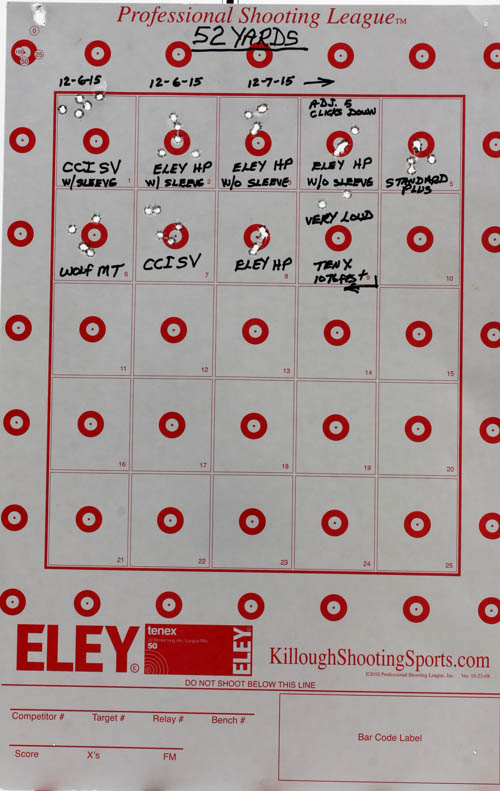
I also fired a couple rounds of the Eley Tenex listed at 1076 feet per
second on the box but those rounds are at/or above subsonic; very, very loud
even suppressed. Ammunition approaching 1105 feet per second at
outside temperature of 48 degrees F., the suppressor does very little to
reduce the crack of the sound wave. The Eley subsonic hollow point 40
grain bullets grouped the best this morning and a couple of the Wolf rounds
were hot and went high on the target. So far, I am really impressed
with the Eley 40 grain hollow point subsonic round rated at 1040 feet per
second.
I sent the above pix to my friend Robert Webster in Hamlet, NC and he got
fired up and went out and shot a 5 round group and sent the pix to me and
here it is:
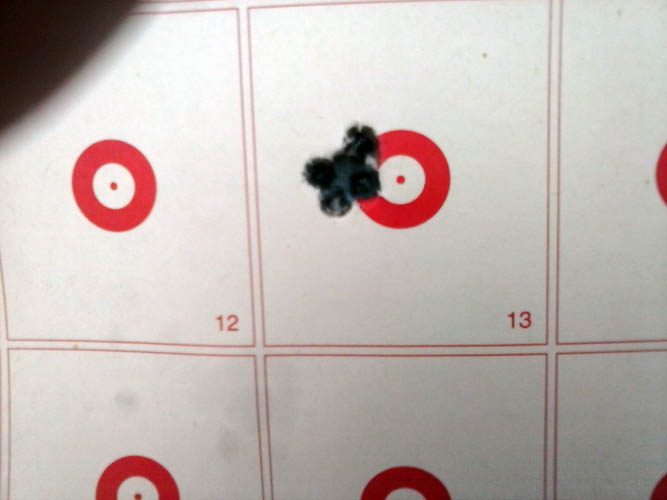
I must confess that is one of the best groups fired at 50 yards in a good
while and to top it off, I gave him the box of Eley 40 grain hollow point
subsonic rounds....grin if you must! Robert's Mark II BTV will
outshoot my Mark II BTVLSS on any given day of the week. 12-07-15.
ELEY SUBSONIC 40 GRAIN HOLLOW POINT TESTING
I recently removed the barrel tuner bushing, barrel pressure point and
cleaned the bore and chamber and started testing some of the ammunition
formed with the Neal Waltz Die of which it will make a hunting round out of
some of the standard available ammo that is not available in the hollow
point configuration. Check out the
Neal Waltz Die page.
I fired 25 rounds of the Eley Subsonic 40 grain hollow point bullets with
a velocity claimed of 1040 feet per second and below is the target fired at
52 yards and the worksheet of each round fired:

